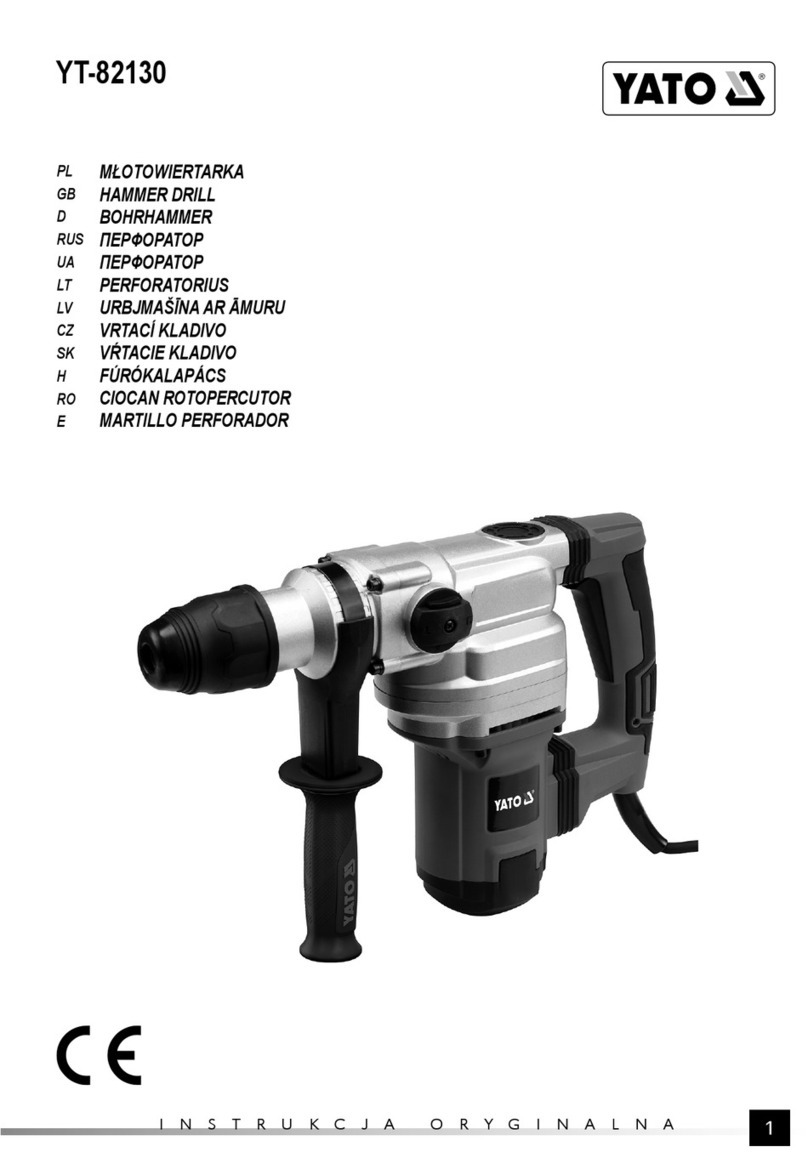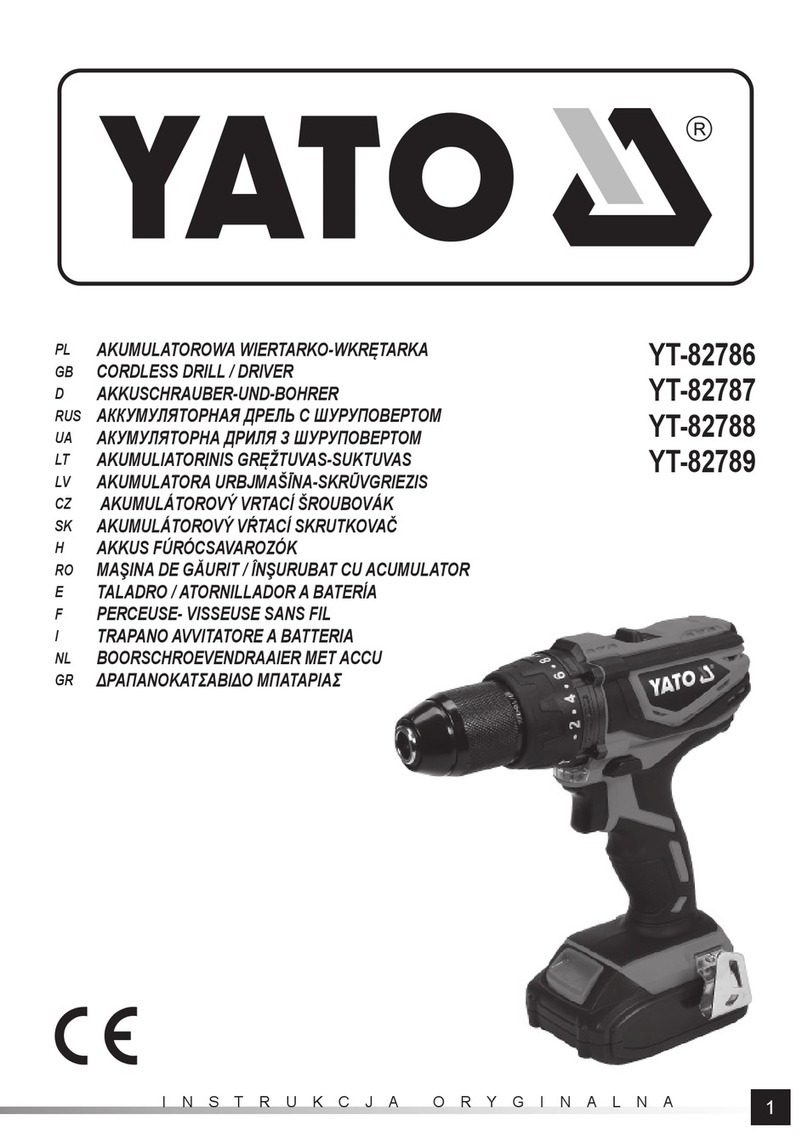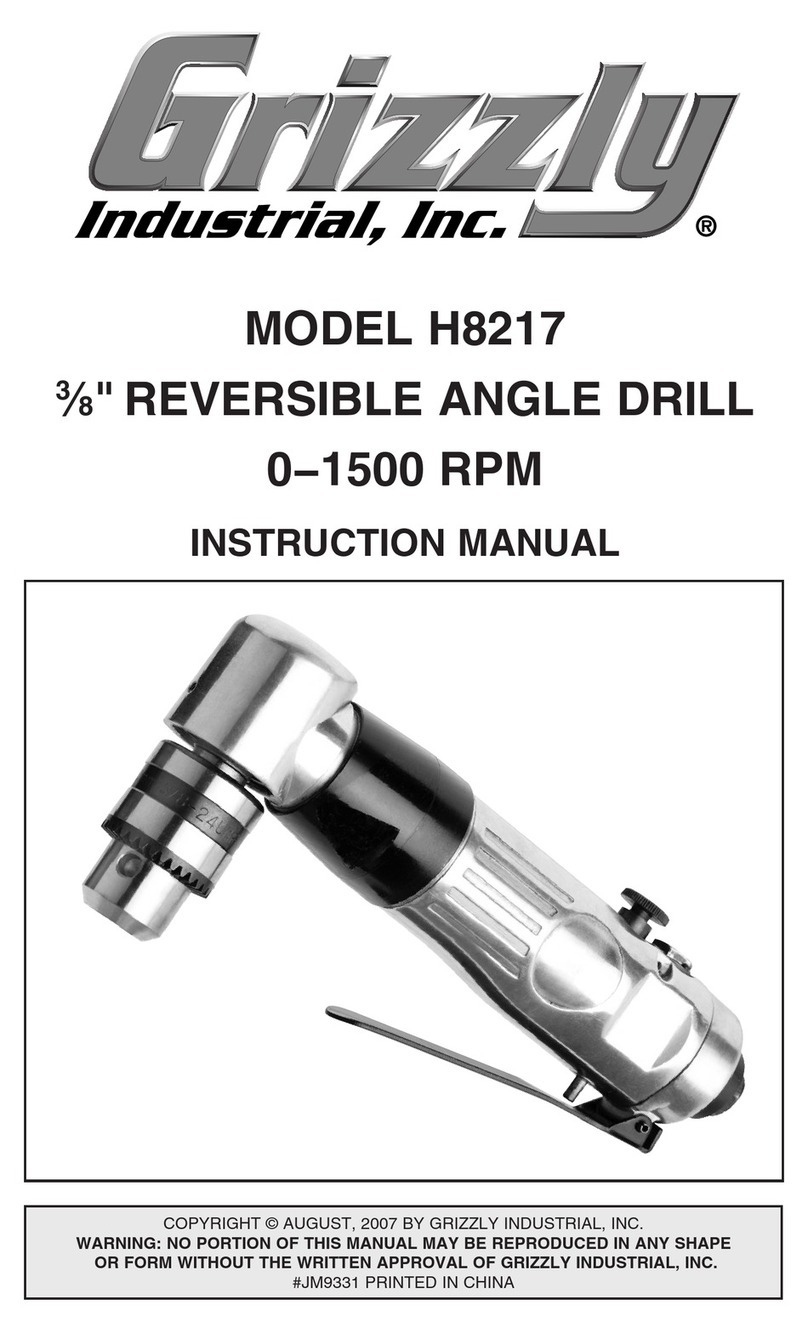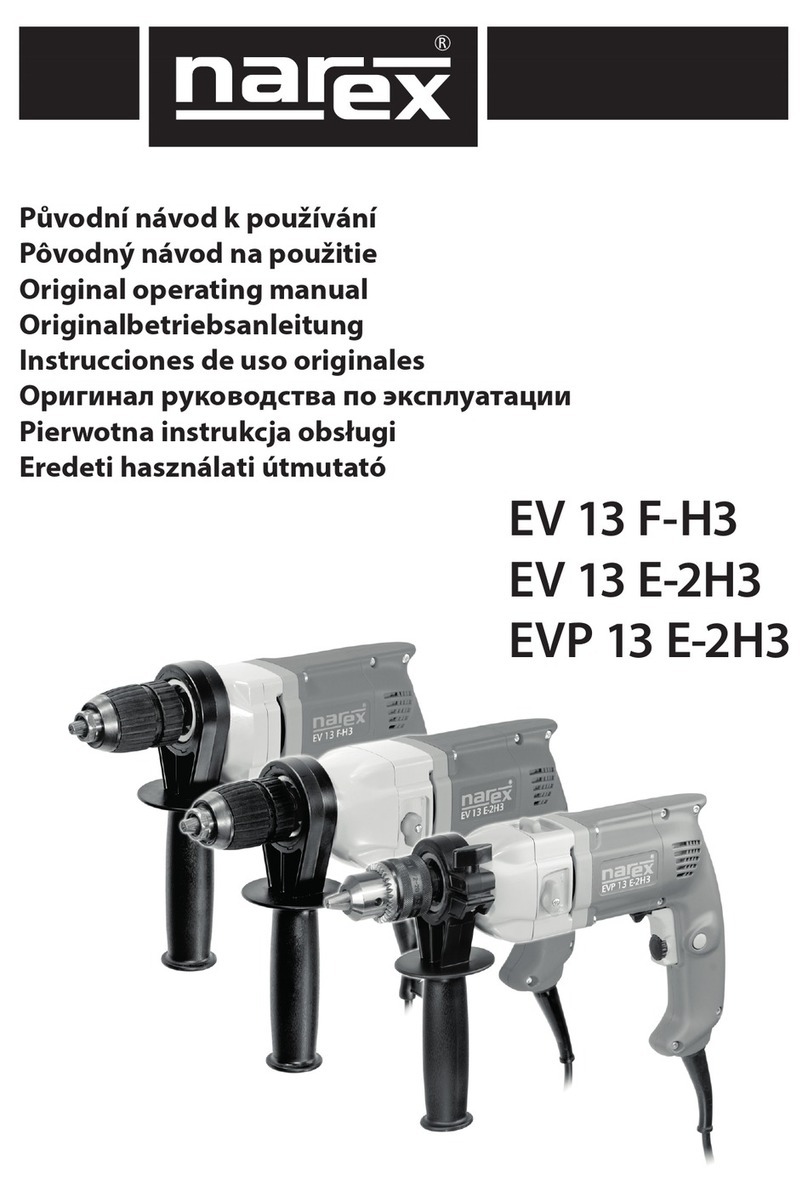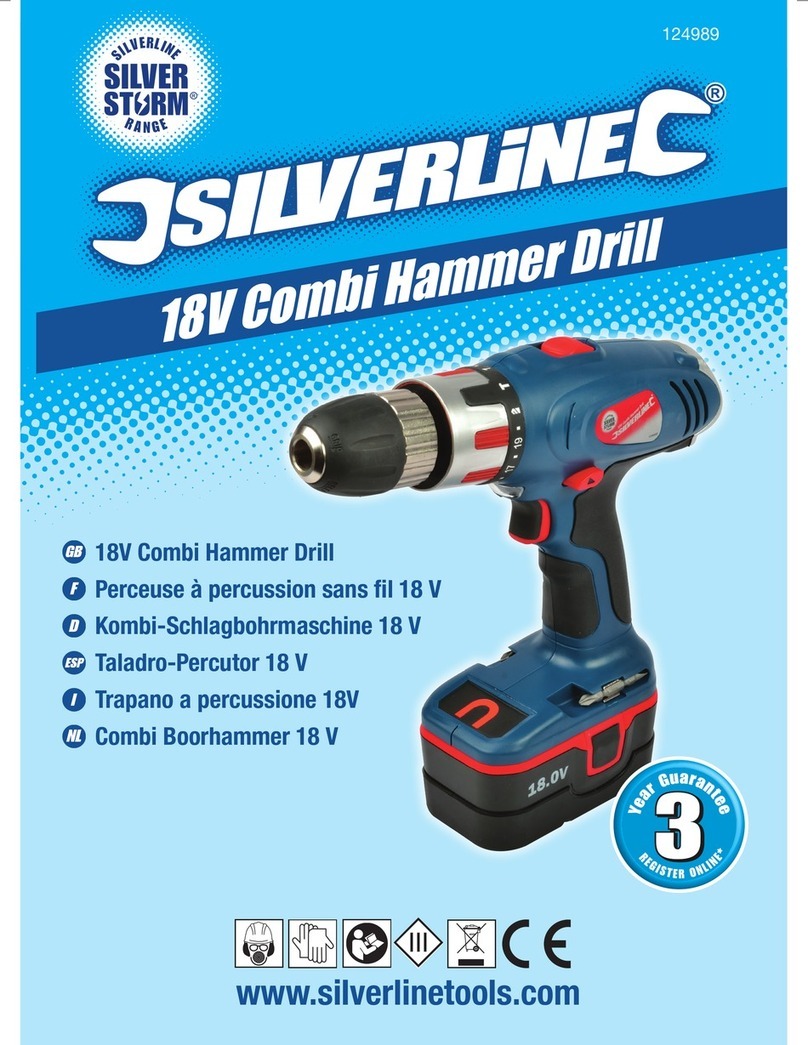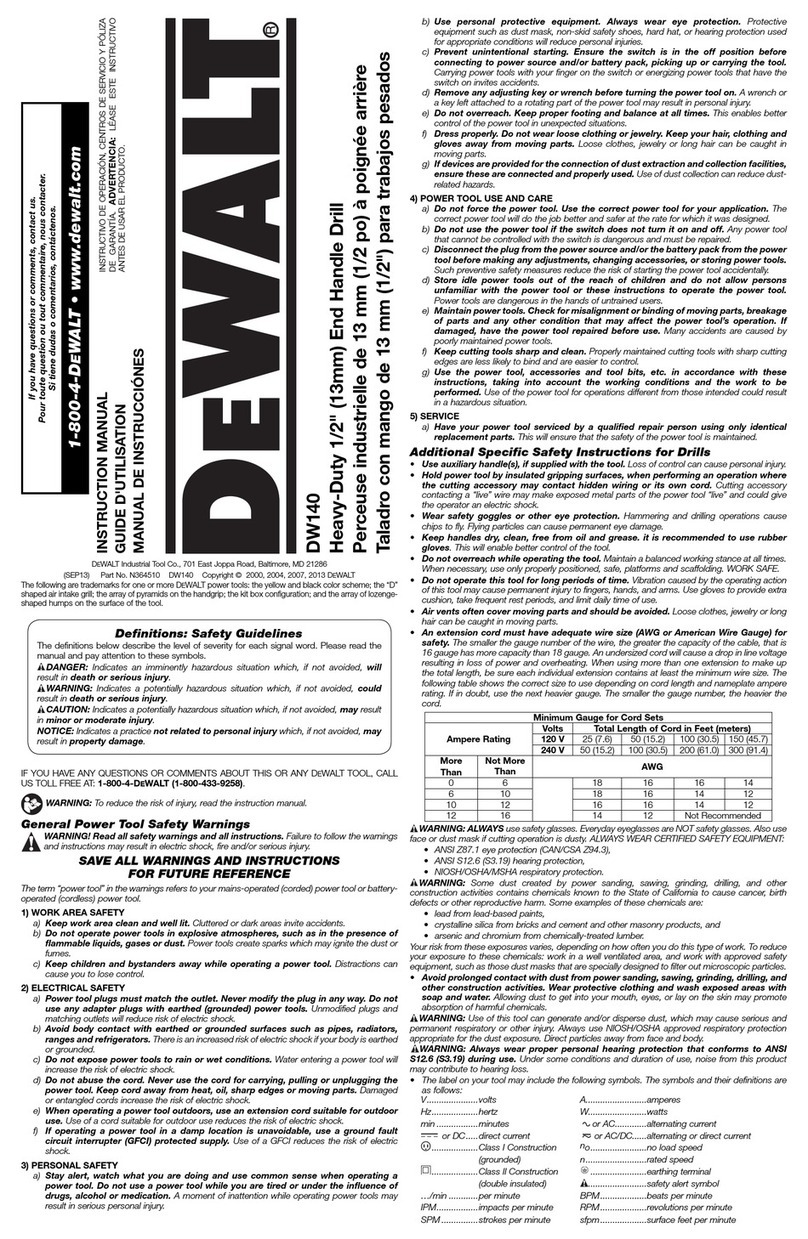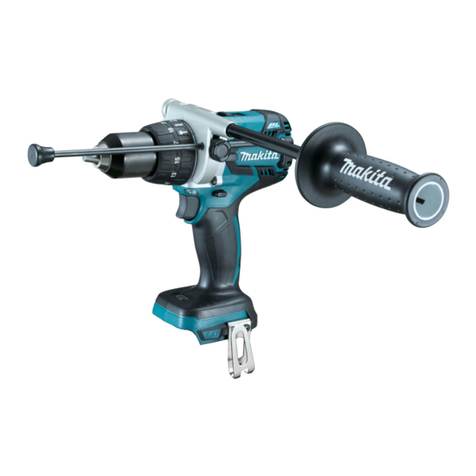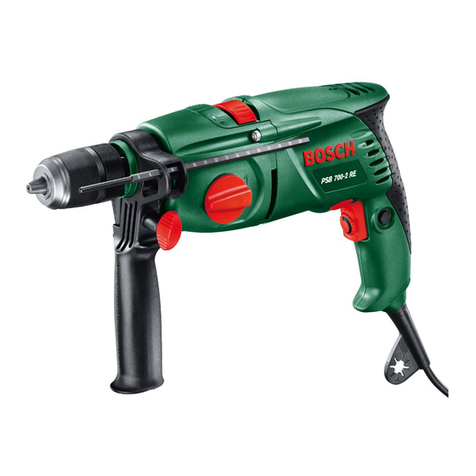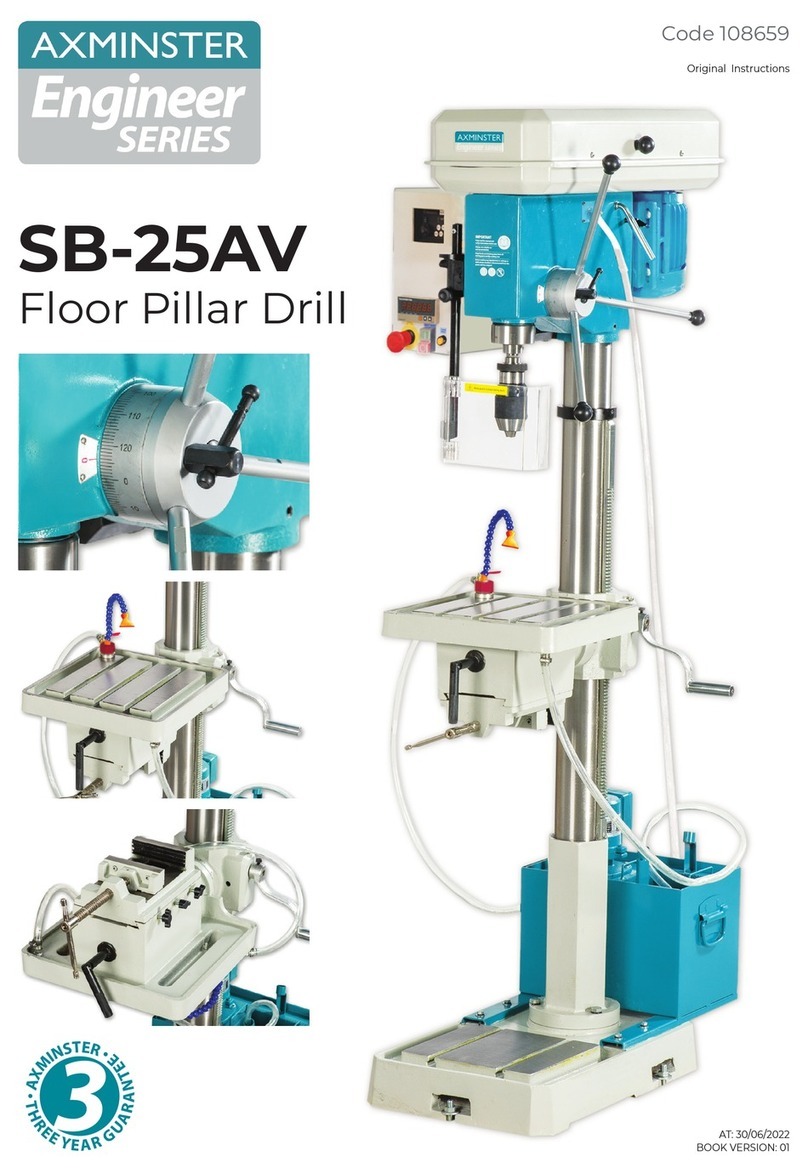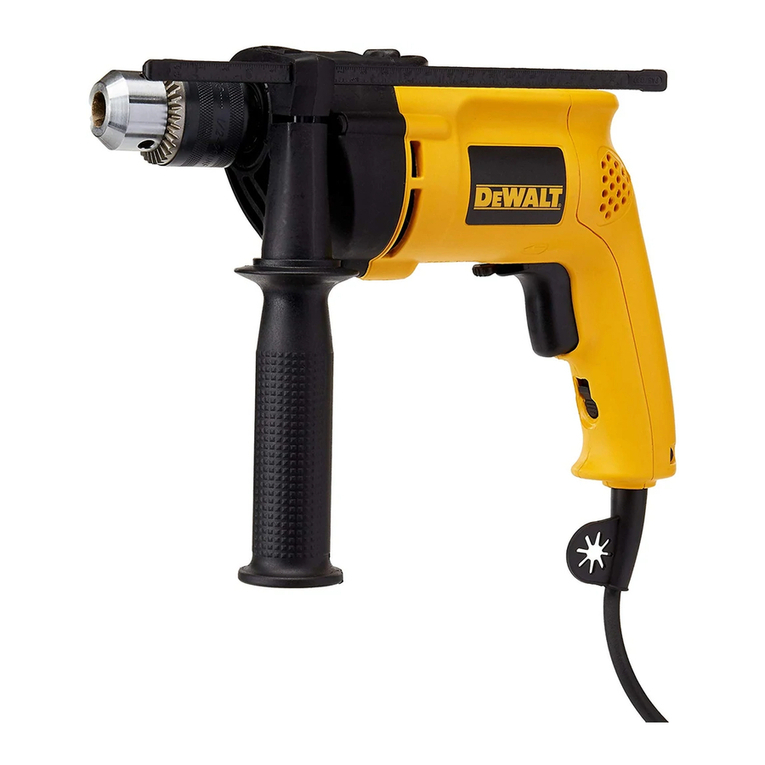YATO YT-09702 User manual

INSTRUKCJA ORYGINALNA 1
YT-09702
WIERTARKA PNEUMATYCZNA
REVERSIBLE AIR DRILL
DRUCKLUFT-BOHRMASCHINE MIT STAHL-ZAHNKRANZFUTTER
ПНЕВМАТИЧЕСКАЯ ДРЕЛЬ
ПНЕВМАТИЧНА ДРЕЛЬ
PNEUMATINIS GRĄŽTAS
PNEIMATISKAIS URBIS
VRTAČKA RUČNÍ VZDUCHOVA
VŔTAČKA RUČNÁ VZDUCHOVÁ
PNEUMATIKUS FÚRÓGÉP
MASINA DE GAURIT PNEUMATICA MANDRINA
TALADRADORA NEUMÁTICA
PERÇEUSE PNEUMATIQUE REVERSIBLE
TRAPANO PNEUMATICO
PNEUMATISCHE BOORMACHINE
ΠΝΕΥΜΑΤΙΚΟ ΔΡAΠΑΝΟ
PL
GB
D
RUS
UA
LT
LV
CZ
SK
H
RO
E
F
I
NL
GR

INSTRUKCJA ORYGINALNA
2
PL D RUS UA LT LV CZ SK H RO E F I NL GR
Rok produkcji:
Production year: Produktionsjahr:
Год выпуска:Рік випуску:
Pagaminimo metai:
2022 Ražošanas gads:
Rok výroby: Rok výroby:
Gyártási év: Anul producţiei utilajului:
Año de fabricación:
TOYA S.A. ul. Sołtysowicka 13-15, 51-168 Wrocław, Polska; www.yato.com
1. wlot powietrza
2. złączka wlotu powietrza
3. spust
4. przełącznik kierunku obrotów
5. uchwyt wiertarski
6. kluczyk do uchwytu wiertarskiego
8. narzędzie
9. gniazdo węża
10. wąż
11. złączka węża
12. smarownica
13. reduktor
14. filtr
15. kompresor
1. air inlet
2. air inlet coupler
3. trigger
4. rotational direction switch
5. chuck
6. chuck key
8. tool
9. air hose socket
10. air hose
11. air hose coupler
12. oiler
13. regulator
14. filter
15. compressor
1. Lufteinlauf
2. Lufteinlaufnippel
3. Schalter
4. Drehrichtungsschalter
5. Bohrerfutter
6. Schüssel des Werkzeugfutters
8. Werkzeug
9. Schlauchsitz
10. Schlauch
11. Schlauchnippel
12. Öler
13. Druckminderer
14. Filter
15. Kompressor
PL GB D
III
I
IV
II
V
5
4
3
2
1
6

INSTRUKCJA ORYGINALNA 3
PL D RUS UA LT LV CZ SK H RO E F I NL GR
1. входное воздушное отверстие
2. соединитель
3. выключатель
4. реверсивный переключатель
5. сверлильный патрон
6. ключ от патрона
8. устройство
9. гнездо шланга
10. шланг
11. соединитель шланга
12. масленка
13. редуктор
14. фильтр
15. компрессор
RUS
1. levegőbemenet
2. a levegőbemenet csatlakozója
3. szelep
4. forgásirány váltó
5. fúrótokmány
6. tokmánykulcs
8. szerszám
9. tömlőfogadó csatlakozó
10. tömlő
11. tömlőcsatlakozója
12. zsírzó
13. nyomáscsökkentő
14. szűrő
15. kompresszor
1. oro įėjimas
2. oro įėjimo atvamzdis
3. paleidimo spaustukas
4. sukimosi krypties perjungiklis
5. griebtuvas
6. kluczyk do uchwytu wiertarskiego
8. įrankis
9. žarnos lizdas
10. žarna
11. žarnos mova
12. tepalinė
13. reduktorius
14. filtras
15. kompresorius
UA LT
1. gaisa pievads
2. gaisa pievada savienojums
3. laidene
4. apgriezienu virziena pārslēdzējs
5. urbjmašīnas turētājs
6. urbjmašīnas turētāja atslēga
8. ierīce
9. vada ligzda
10. vads
11. vada savienojums
12. eļļošanas instruments
13. reduktors
14. filtrs
15. kompresors
LV
1. vstup vzduchu
2. spojka vstupu vzduchu
3. spoušť
4. přepínačsměru otáček
5. vrtací sklíčidlo
6. klíček od vrtacího sklíčidla
8. nástroj
9. zásuvka hadice
10. hadice
11. spojka hadice
12. olejovač
13. redukční ventil
14. filtr
15. kompresor
1. vstup vzduchu
2. spojka vstupu vzduchu
3. spúšť
4. prepínačsmeru otáčok
5. vŕtacie skľúčovadlo
6. kľúčik ku vŕtaciemu skľúčovadlu
8. nástroj
9. hadicová zásuvka
10. hadica
11. hadicová spojka
12. olejovač
13. redukčný ventil
14. filter
15. kompresor
CZ SK
1. вхідний повітряний отвір
2. зєднувач
3. вимикач
4. реверсивний перемикач
5.свердлувальний патрон
6. ключ від патрона
8. пристрій
9. гніздо шланга
10. шланг
11. зєднувач шланга
12. маслянка
13. редуктор
14. фільтр
15. компресор
1. orificiul intrării aerului
2. mufa intrării aerului
3. trăgaciul
4. comutatorul schimbării dircţiei de rotire
5. mandrina
6. cheia pentru mandrină
8. scula ajutătoare
9. soclul tubului
10. tub
11. mufa tubului
12. gresor
13. reduktor
14. filtru
15. compresor
1. entrada de aire
2. conector de la entrada de aire
3. gatillo
4. interruptor de la dirección de giro
5. agarradera del taladrador
6. llaves para la agarradera del taladrador
8. herramienta
9. entrada de la manguera
10. manguera
11. conector de la manguera
12. lubricador
13. reductor
14. filtro
15. compresor
HROE
1. entrée d’air
2. connecteur d’entrée d’air
3. declenchement
4. commutateur de rotation
5. mandrin
6. clé de mandrin
8. outil
9. prise de tuyau
10. tuyau
11. raccord de tuyau
12. graisseur
13. régulateur
14. filtre
15. compresseur
1. presa d’aria
2. raccordo della presa d’aria
3. grilletto
4. selettore della direzione di rotazione
5. mandrino a cremagliera
6. chiave per mandrino
8. strumento
9. sede del tubo
10. tubo
11. raccordo del tubo
12. lubrificatore
13. riduttore
14. filtro
15. compressore
1. luchtinlaat
2. aansluiting luchtinlaat
3. afvoer
4. schakelaar toerentalrichting
5. boorkop
6. sleutel voor boorkop
8. werktuig
9. contactdoos slang
10. slang
11. slangaansluiting
12. smeermiddel
13. reduceertoestel
14. filter
15. compressor
FI NL
1. εισαγωγή αέρα
2. βύσμα εισαγωγής αέρος
3. σκανδάλη
4. διακόπτης κατεύθυνσης περιστροφής
5. συγκρατήρας(τσοκ) τρυπανιών
6. κλειδί για τον συγκρατήρα τρυπανιών
8. εργαλείο
9. υποδοχή σωλήνας (hose socket)
10. σωλήνα
11. σύνδεσμος σωλήνας (hose connector)
12. γρασαδόρος
13. μειωτήρας (reducer)
14. φίλτρο
15. συμπιεστής
GR

INSTRUKCJA ORYGINALNA
4
PL D RUS UA LT LV CZ SK H RO E F I NL GR
Kierunek obrotów
Rotating direction
Drehrichtung
Направление вращения
Напрям обертання
Apsisukimųkryptis
Griezes virziens
Směr otáčení
Smer otáčania
Forgásirány
Direcţie turaţii
Dirección de la rotación
Sens de rotation
Direzione dei giri
Toerentalrichting
Κατεύθυνση περιστροφής
Przeczytaćinstrukcję
Read the operating instruction
Bedienungsanleitung durchgelesen
Прочитать инструкцию
Прочитать iнструкцiю
Perskaityti instrukciją
Jālasa instrukciju
Přečtet návod k použití
Prečítaťnávod k obsluhe
Olvasni utasítást
Citeşti instrucţunile
Lea la instrucción
Lire les instructions d’utilisation
Leggere l’istruzione operativa
Lees de gebruiksaanwijzing
Διαβάστε τις οδηγίες λειτουργίας
Używaćgogle ochronne
Wear protective goggles
Schutzbrille tragen
Пользоваться защитными очками
Користуйтесь захисними окулярами
Vartok apsauginius akinius
Jālieto drošības brilles
Používej ochranné brýle
Používaj ochranné okuliare
Használjon védőszemüveget!
Intrebuinţeazăochelari de protejare
Use protectores del oído
Porter des lunettes de protection
Indossare occhiali protettivi
Draag beschermende bril
Φορέστε προστατευτικά γυαλιά
Używaćochrony słuchu
Wear hearing protectors
Gehörschutz tragen
Пользоваться средствами защиты слуха
Користуйтесь засобами захисту слуху
Vartoti ausines klausai apsaugoti
Jālieto dzirdes drošības līdzekļu
Používej chrániče sluchu
Používaj chrániče sluchu
Használjon fülvédőt!
Intrebuinţeazăantifoane
Use protectores de la vista
Porter des protecteurs auditifs
Indossare protezioni acustiche
Draag gehoorbeschermers
Φορέστε προστατευτικά ακοής
Stosowaćrękawice ochronne
Use protective gloves
Schutzhandschuhe verwenden
Необходимо пользоваться защитными перчатками
Слід користуватися захисними рукавицями
Vartoti apsaugines pirštines
Lietot aizsardzības cimdus
Používejte ochranné rukavice
Používajte ochranné rukavice
Használjon védőkesztyűt
Utilizarea mănuşilor de protrcţie
Use guantes de protección
Portez des gants de protection
Utilizzare i guanti di protezione
Gebruik beschermende handschoenen
Φορέστε τα γάντια προστασίας

INSTRUKCJA ORYGINALNA 5
PL
CHARAKTERYSTYKA NARZĘDZIA
Wiertarka pneumatyczna jest narzędziem zasilanym strumieniem sprężonego powietrza pod odpowiednim ciśnieniem. Za pomo-
cąwiertełmocowanych w uchwycie umożliwia wiercenie w metalach, drewnie, tworzywach sztucznych oraz wszędzie tam, gdzie
wymagane jest wiercenie bez udaru. Narzędzia sąprzystosowane do pracy wewnątrz pomieszczeńi nie należy wystawiaćich na
działanie wilgoci oraz opadów atmosferycznych. Prawidłowa, niezawodna i bezpieczna praca narzędzia jest zależna od właściwej
eksploatacji, dlatego:
Przed przystąpieniem do pracy z narzędziem należy przeczytaćcałą instrukcjęi zachowaćją.
Za wszelkie szkody i obrażenia powstałe w wyniku używania narzędzia niezgodnie z przeznaczeniem, nie przestrzegania prze-
pisów bezpieczeństwa i zaleceńniniejszej instrukcji, dostawca nie ponosi odpowiedzialności. Używanie narzędzia niezgodnie z
przeznaczeniem, powoduje także utratępraw użytkownika do gwarancji, a także z tytułu niezgodności z umową.
WYPOSAŻENIE
Wiertarka jest wyposażona w złączkępozwalającąprzyłączyćjądo układu pneumatycznego. Na wyposażeniu znajduje siętakże
kluczyk umożliwiający zamocowanie narzędzia roboczego w uchwycie wiertarskim
DANE TECHNICZNE
Parametr Jednostka miary Wartość
Numer katalogowy YT-09702
Waga [kg] 1,7
Średnica przyłącza powietrza (PT) [mm / ”] 6,3 / 1/4
Średnica węża doprowadzającego powietrze (wewnętrzna) [mm / ”] 10/ 3/8
Obroty [min-1] 700
Maksymalna średnica wiertła [mm] 10
Maksymalne ciśnienie pracy [MPa] 0,63
Wymagany przepływ powietrza (przy 0,63 MPa) [l/min] 198
Ciśnienie akustyczne (ISO 15744) [dB(A)] 89,7 ± 3,0
Moc akustyczna (ISO 15744) [dB(A)] 100,7 ± 3,0
Drgania (ISO 28927-5) [m/s2] 0,89 ± 1,5
OGÓLNE WARUNKI BEZPIECZEŃSTWA
OSTRZEŻENIE! Podczas pracy narzędziem pneumatycznym zaleca sięzawsze przestrzegaćpodstawowych zasad bezpieczeń-
stwa pracy, łącznie z podanymi niżej, w celu ograniczenia zagrożenia pożarem, porażenia prądem elektrycznym oraz uniknięcia
obrażeń.
Przed przystąpieniem do eksploatacji niniejszego narzędzia przeczytaćcałą instrukcjęi zachowaćją.
UWAGA! Przeczytaćwszystkie poniższe instrukcje. Nieprzestrzeganie ich może prowadzićdo porażenia elektrycznego, pożaru
albo do uszkodzeńciała. Pojęcie „narzędzie pneumatyczne” użyte w instrukcjach odnosi siędo wszystkich narzędzi napędzanych
sprężonym strumieniem powietrza pod odpowiednim ciśnieniem.
PRZESTRZEGAĆPONIŻSZE INSTRUKCJE
Ogólne zasady bezpieczeństwa
Przed rozpoczęciem instalacji, pracy, naprawy, konserwacji oraz zmiany akcesoriów lub w przypadku pracy w pobliżu narzędzia
pneumatycznego z powodu wielu zagrożeń, należy przeczytaći zrozumiećinstrukcje bezpieczeństwa. Nie wykonanie powyż-
szych czynności może skutkowaćpoważnymi obrażeniami ciała. Instalacja, regulacja i montażnarzędzi pneumatycznych może
byćwykonywany tylko przez wykwalifikowany i wyszkolony personel. Nie modyfikowaćnarzędzia pneumatycznego. Modyfikacje
mogązmniejszyćefektywność oraz poziom bezpieczeństwa oraz zwiększyćryzyko operatora narzędzia. Nie wyrzucaćinstrukcji
bezpieczeństwa, należy je przekazaćoperatorowi narzędzia. Nie używaćnarzędzia pneumatycznego, jeżeli jest uszkodzone.
Narzędzie należy poddawaćokresowej inspekcji pod kątem widoczności danych wymaganych normąISO 11148. Pracodawca/
użytkownik powinien skontaktowaćsięz producentem w celu wymiany tabliczki znamionowej za każdym razem gdy jest to
konieczne.
Zagrożenia związane z wyrzucanymi częściami
Odłączyćnarzędzie od źródła zasilania przed wymianąnarzędzia wstawionego lub akcesoria. Uszkodzenie obrabianego przed-

INSTRUKCJA ORYGINALNA
6
PL
miotu, akcesoriów lub nawet narzędzia wstawianego może spowodowaćwyrzucenie części z dużą prędkością. Zawsze należy
stosowaćochronęoczu odpornąna uderzenia. Stopieńochrony należy dobieraćw zależności od wykonywanej pracy. Należy
sięupewnić, ze obrabiany przedmiot jest bezpiecznie zamocowany. W przypadku pracy narzędziem nad głową, stosowaćhełm
ochronny. Należy równieżbraćpod uwagęryzyko wobec osób postronnych. Należy sięupewnić, ze obrabiany przedmiot jest
bezpiecznie zamocowany. Nie pracowaćnarzędziem bez upewnienia się, że zostałzainstalowany ogranicznik narzędzia wstawia-
nego. Aby uniknąć obrażeń, należy wymieniaćogranicznik kiedy zostanie zużyty, pęknięty lub zniekształcony. Pewnie przyłożyć
narzędzie wstawiane do obrabianej powierzchni przed rozpoczęciem pracy.
Zagrożenia związane z pracą
Użytkowanie narzędzia może wystawićręce operatora na zagrożenia, takie jak: zmiażdżenie, uderzenie, odcięcie, ścieranie oraz
gorąco. Należy ubieraćwłaściwe rękawice do ochrony rąk. Operator oraz personel konserwujący powinni byćfizycznie zdolni do
poradzenia sobie z ilością, masąoraz mocąnarzędzia. Trzymaćnarzędzie poprawnie. Zachowaćrównowagęoraz zapewniające
bezpieczeństwo ustawienie stóp. Należy zwolnićnacisk na urządzenie startu i stopu w przypadku przerwy w dostawie energii
zasilającej. Używaćtylko środków smarnych zalecanych przez producenta. Unikaćbezpośredniego kontaktu z narzędziem wsta-
wianym podczas oraz po pracy, może byćgorące. Należy stosowaćokulary ochronne, zalecane jest stosowanie dopasowanych
rękawic oraz stroju ochronnego.
Zagrożenia związane z powtarzalnymi ruchami
Podczas stosowania narzędzia pneumatycznego do pracy polegającej na powtarzaniu ruchów, operator jest narażony na do-
świadczenie dyskomfortu dłoni, ramion, barków, szyi lub innych części ciała. W przypadku użytkowania narzędzia pneumatycz-
nego, operator powinien przyjąć komfortowąpostawęzapewniającąwłaściwe ustawienie stóp oraz unikaćdziwnych lub nie
zapewniających równowagi postaw. Operator powinien zmieniaćpostawępodczas długiej pracy, pomoże to uniknąć dyskomfortu
oraz zmęczenia. Jeżeli operator doświadcza symptomów takich jak: trwały lub powtarzający siędyskomfort, ból, pulsujący ból,
mrowienie, drętwienie, pieczenie lub sztywność. Nie powinien ich ignorować, powinien powiedziećo tym pracodawcy i skonsul-
towaćsięz lekarzem.
Zagrożenia związane z akcesoriami
Odłączyćnarzędzie od źródła zasilania przed zmianąnarzędzia wstawionego lub akcesoria. Stosowaćakcesoria i materiały eks-
ploatacyjne tylko w rozmiarach i typach, które sązalecane przez producenta. W przypadku młotków, w stosownych przypadkach,
nigdy nie używaćjakichkolwiek dłut jako narzędzi ręcznych. Zostały one specjalnie zaprojektowane i poddane obróbce cieplnej
pod kątem wykorzystania jedynie w nieobrotowych narzędziach udarowych. W przypadku młotków i kruszarek, w stosownych
przypadkach, nigdy nie używaćtępych dłut, ponieważsąone poddawane dużemu obciążeniu i może pęknąć ze względu zmęcze-
nia materiału. Użycie tępego narzędzia może zwiększyćwibracje i dlatego zawsze powinno sięstosowaćnaostrzone narzędzia.
W przypadku młotków, w stosownych przypadkach, nigdy nie chłodzićgorących narzędzi wstawianych w wodzie, może to skut-
kowaćkruchościąi przedwczesnym zużyciem. W przypadku młotków, w stosownych przypadkach, uszkodzenie lub pękniecie
narzędzia może wynikaćz niewłaściwego wykorzystania narzędzia jako dźwigni, np. przy podważaniu. Lepiej pracować, usuwa-
jąc mniejsze fragmenty, co pozwoli uniknąć zacięć. Unikaćbezpośredniego kontaktu z narzędziem wstawianym podczas oraz po
pracy, może byćgorące lub ostre.
Zagrożenia związane z miejscem pracy
Poślizgnięcia, potknięcia i upadki sągłównymi przyczynami obrażeń. Wystrzegaćsię, śliskich powierzchni spowodowanych użyt-
kowaniem narzędzia, a także zagrożeńpotknięciem spowodowanym instalacjąpowietrzną. Postępowaćostrożnie w nieznanym
otoczeniu. Mogąistniećukryte zagrożenia, takie jak elektryczność lub inne linii użytkowe. Narzędzie pneumatyczne nie jest
przeznaczone do stosowania w strefach zagrożonych wybuchem i nie jest izolowane od kontaktu z energiąelektryczną. Upewnić
się, że nie istniejążadne przewody elektryczne, rury gazowe, itp., które mogąpowodowaćzagrożenie w przypadku uszkodzenia
przy użyciu narzędzia.
Zagrożenia związane z oparami i pyłami
Pyłi opary powstałe przy użyciu narzędzia pneumatycznego mogąspowodowaćzły stan zdrowia (na przykład raka, wady wrodzo-
ne, astma i/ lub zapalenie skóry), niezbędne są: ocena ryzyka i wdrożenie odpowiednich środków kontroli w odniesieniu do tych
zagrożeń. Ocena ryzyka powinna zawieraćwpływ pyłu utworzonego przy użyciu narzędzia i możliwość wzburzenia istniejącego
pyłu. Wylot powietrza należy tak kierować, aby zminimalizowaćwzbudzanie pyłu w zakurzonym środowisku. Tam gdzie powstają
pyłlub opary, priorytetem powinna byćkontrola ich w źródle emisji. Wszystkie zintegrowane funkcje i wyposażenie do zbierania,
ekstrakcji lub zmniejszenia pyłu lub dymu powinny byćprawidłowo użytkowane i utrzymywane zgodnie z zaleceniami producenta.
Używaćochrony dróg oddechowych, zgodnie z instrukcjami pracodawcy oraz zgodnie z wymogami higieny i bezpieczeństwa.
Obsługęi konserwacjęnarzędzia pneumatycznego należy przeprowadzaćwedług zaleceńinstrukcji obsługi, pozwoli zminimali-
zowaćemisjęoparów i pyłu. Wybierać, konserwowaći wymieniaćnarzędzia wstawiane według zaleceńinstrukcji, aby zapobiec
wzrostowi oparów i pyłu.
Zagrożenie hałasem
Narażenie, bez zabezpieczeń, na wysoki poziom hałasu może spowodowaćtrwałą i nieodwracalnąutratęsłuchu oraz inne pro-

INSTRUKCJA ORYGINALNA 7
PL
blemy, takie jak szum w uszach (dzwonienie, brzęczenie, gwizdanie lub buczenie w uszach). Niezbędna jest ocena ryzyka oraz
wdrożenie odpowiednich środków kontroli w odniesieniu do tych zagrożeń. Odpowiednie kontrole w celu zmniejszenia ryzyka
mogąobejmowaćdziałania takie jak: materiały tłumiące zapobiegające „dzwonieniu” obrabianego przedmiotu. Używaćochrony
słuchu zgodnie z instrukcjami pracodawcy oraz zgodnie z wymogami higieny i bezpieczeństwa. Obsługęi konserwacjęnarzędzia
pneumatycznego należy przeprowadzaćwedług zaleceńinstrukcji obsługi, pozwoli uniknąć niepotrzebnego wzrostu poziomu
hałasu. Jeżeli narzędzie pneumatyczne posiada tłumik, zawsze należy upewnićsię, że jest prawidłowo zamontowany podczas
użytkowania narzędzia. Wybrać, konserwowaći wymienićzużyte narzędzia wstawiane według zaleceńinstrukcji obsługi. Pozwoli
to uniknąć niepotrzebnego wzrostu hałasu.
Zagrożenie drganiami
Narażenie na drgania może spowodowaćtrwałe uszkodzenia nerwów i ukrwienia rąk oraz ramion.
Należy sięciepło ubraćpodczas pracy w niskich temperaturach oraz utrzymywaćręce ciepłe i suche. Jeśli wystąpi drętwienie,
mrowienie, ból lub wybielanie skóry w palcach i dłoni, zaprzestaćużywania narzędzia pneumatycznego, następnie poinformować
pracodawcęoraz skonsultowaćsięz lekarzem. Obsługa i konserwacja narzędzia pneumatycznego według zaleceńinstrukcji
obsługi, pozwoli uniknąć niepotrzebnego wzrostu poziomu drgań. Nie trzymaćnarzędzia wstawianego wolnąręką, zwiększa to
ekspozycjęna drgania. Trzymaćnarzędzie lekkim, ale pewnym chwytem, z uwzględnieniem wymaganych siłreakcji, ponieważ
zagrożenie pochodzące od drgańjest zazwyczaj większe, gdy siła chwytu jest wyższa. Utrzymywaćrękojeści dodatkowe z po-
zycji centralnej oraz unikaćnacisku na rękojeść do momentu zatrzymania. W przypadku kruszarek usuwaćmniejsze fragmenty
betonu, aby zapobiec zaklinowaniu sięnarzędzia. W przypadku kruszarek, przemieszczaćnarzędzie co kilka sekund. Podczas
przemieszczania należy narzędzie zatrzymać, ponieważdrgania osiągająwysoki poziom jeżeli narzędzie wstawiane nie opiera
sięo obrabiany materiał.
Dodatkowe instrukcje bezpieczeństwa dotyczące narzędzi pneumatycznych
Powietrze pod ciśnieniem może spowodowaćpoważne obrażenia:
- zawsze odciąć dopływ powietrza, opróżnićwąż z ciśnienia powietrza i odłączyćnarzędzie od dopływu powietrza, gdy: nie jest
używane, przed wymianąakcesoriów lub przy wykonywaniem napraw;
- nigdy nie kierowaćpowietrza na siebie lub kogokolwiek innego.
Uderzenie wężem może spowodowaćpoważne obrażenia. Zawsze należy przeprowadzićkontrolępod kątem uszkodzonych lub
luźnych węży i złączek. Zimne powietrze należy kierowaćz dala od rąk
Za każdym razem gdy sąstosowane uniwersalne połączenia zakręcane (połączenia kłowe), należy zastosowaćtrzpienie zabez-
pieczające i łączniki zabezpieczające przeciwko możliwości uszkodzenia połączeńpomiędzy wężami oraz pomiędzy wężem i
narzędziem. Nie przekraczaćmaksymalnego ciśnienia powietrza podanego dla narzędzia.
Nigdy nie przenosićnarzędzia, trzymając za wąż.
WARUNKI EKSPLOATACJI
Należy upewnićsię, że źródło sprężonego powietrza pozwala wytworzyćwłaściwe ciśnienie robocze oraz zapewnia wymagany
przepływ powietrza. W przypadku zbyt dużego ciśnienia powietrza zasilającego należy zastosowaćreduktor wraz z zaworem
bezpieczeństwa. Narzędzie pneumatyczne należy zasilaćprzez układ filtra i smarownicy. Zapewni to jednocześnie czystość i
nawilżenie powietrza olejem. Stan filtra i smarownicy należy sprawdzaćprzed każdym użyciem i ewentualnie oczyścićfiltr lub
uzupełnićniedobór oleju w smarownicy. Zapewni to właściwąeksploatacjęnarzędzia i przedłuży jego żywotność.
Przy dużych obciążeniach zawsze stosowaćuchwyt dodatkowy.
W przypadku zatrzymania sięwiertła, np. na skutek zakleszczenia lub podczas przechodzenia przez wiercony materiał, mogąwyzwo-
lićsięduże siły obrotowe działające na narzędzie. Należy przyjąć takąpostawę, aby móc skutecznie przeciwdziałaćtakim siłom.
Niespodziewany ruch narzędzia lub pękniecie wiertła, może byćprzyczynąobrażeń.
W przypadku stosowania dodatkowych uchwytów lub stojaków podtrzymujących, należy sięupewnić, że narzędzie zostało pra-
widłowo i pewnie zamocowane.
Należy przyjąć odpowiedniąpostawępozwalającąprzeciwdziałaćnormalnemu lub nieoczekiwanemu ruchowi narzędzia wywo-
ływanemu przez moment obrotowy.
Należy trzymaćczęści ciała i odzieży z dala od obracającego sięuchwytu i wiertła. Istnieje ryzyko wciągnięcia lub pochwycenia.
Zawsze należy sięupewnić, że wszelkie klucze i narzędzia użyte do regulacji i mocowania innych narzędzi wstawianych w wier-
tarce, zostały usunięte przed rozpoczęciem wiercenia.
UŻYTKOWANIE NARZĘDZIA
Przed każdym użyciem narzędzia należy upewnićsię, że żaden element układu pneumatycznego nie jest uszkodzony. W przy-
padku zaobserwowania uszkodzeń, należy niezwłocznie wymienićna nowe nieuszkodzone elementy układu.
Przed każdym użyciem układu pneumatycznego należy osuszyćwilgoćskondensowanąwewnątrz narzędzia, kompresora i prze-
wodów.

INSTRUKCJA ORYGINALNA
8
PL
Podłączanie narzędzia do układu pneumatycznego
Rysunek pokazuje zalecany sposób podłączenia narzędzia do układu pneumatycznego. Pokazany sposób zapewni najbardziej
efektywne wykorzystanie narzędzia, a także przedłuży żywotność narzędzia.
Wpuścićkilka kropli oleju o lepkości SAE 10 do wlotu powietrza.
Do gwintu wlotu powietrza mocno i pewnie przykręcićodpowiedniąkońcówkęumożliwiającąprzyłączenie węża doprowadzają-
cego powietrze. (II)
Na zabieraku narzędzia zamocowaćodpowiedniąkońcówkę. Do pracy z narzędziami pneumatycznymi stosowaćtylko wypo-
sażenie przystosowane do pracy z narzędziami udarowymi.
Ustawićodpowiedni kierunek obrotów. Litera F oznacza obroty zgodne z kierunkiem ruchu wskazówek zegara, litera R - obroty
przeciwne do ruchu wskazówek zegara.
Tam gdzie jest to możliwe wyregulowaćciśnienie (moment obrotowy).
Podłączyćnarzędzie do układu pneumatycznego używając węża o wewnętrznej średnicy 10 mm / 3/8”. Upewnićsię, że wytrzy-
małość węża wynosi, co najmniej 1,38MPa. (III)
Uruchomićnarzędzie na kilka sekund upewniając się, że nie dochodząz niego żadne podejrzane dźwięki lub wibracje.
Mocowanie wiertła w uchwycie (IV)
Do uchwytu włożyćwiertło i dokręcićkluczykiem każdy z 3 otworów tak, by było pewnie i mocno zamocowane w uchwycie.
Następnie wyjąć kluczyk z otworu mocującego.
Wiercenie
Wyregulowaćciśnienie w układzie pneumatycznym tak, aby nie przekroczyło wartości maksymalnej dla danego narzędzia.
Ustawićodpowiedni kierunek obrotów narzędzia (F - obroty zgodnie z kierunkiem ruchu wskazówek zegara, R - obroty przeciwnie
do ruchu wskazówek zegara).
Zamontowaćuchwyt dodatkowy, przełożyćobejmęuchwytu przez korpus wiertarki i dokręcićrękojeść. Uchwyt zamocowaćw
pozycji, która zapewni bezpiecznąi ergonomiczna pracę. (V)
W uchwycie zamontowaćodpowiednie wiertło.
Podłączyćwiertarkędo układu pneumatycznego.
Wcisnąć włącznik i sprawdzić, czy wiertło nie wykazuje zbyt dużego bicia osiowego. W razie potrzeby odłączyćwiertarkęod
źródła sprężonego powietrza i wymienićwiertło na nowe.
Przyłożyćwiertło do miejsca, gdzie ma byćwiercony otwór.
Stopniowo naciskaćspust narzędzia.
Aby łatwiej wyprowadzićwiertło z otworu, należy zwolnićnacisk na włącznik, poczekaćdo ustania obrotów wiertła. Przestawić
kierunek obrotów na przeciwny i delikatnie nacisnąć spust. Ostrożnie wyprowadzićwiertło z otworu.
Po skończonej pracy rozmontowaćukład pneumatyczny i zakonserwowaćnarzędzie.
KONSERWACJA
Nigdy nie stosowaćbenzyny, rozpuszczalnika, albo innej palnej cieczy do czyszczenia narzędzia. Opary mogąsięzapalićpowo-
dując wybuch narzędzia i poważne obrażenia.
Rozpuszczalniki użyte do czyszczenia uchwytu narzędziowego i korpusu mogąspowodowaćrozmiękczenie uszczelnień. Dokład-
nie wysuszyćnarzędzie przed rozpoczęciem pracy.
W przypadku stwierdzenia jakichkolwiek nieprawidłowości w działaniu narzędzia, narzędzie należy natychmiast odłączyćod ukła-
du pneumatycznego.
Wszystkie elementy układu pneumatycznego musząbyćzabezpieczone przed zanieczyszczeniami. Zanieczyszczenia, które
dostanąsiędo układu pneumatycznego mogązniszczyćnarzędzie i inne elementy układu pneumatycznego.
Konserwacja narzędzia przed każdym użyciem
Odłączyćnarzędzie od układu pneumatycznego.
Przed każdym użyciem wpuścićniewielkąilość płynu konserwującego (np. WD-40) przez wlot powietrza.
Podłącz narzędzie do układu pneumatycznego i uruchom na około 30 sekund. Pozwoli to rozprowadzićpłyn konserwujący po
wnętrzu narzędzia i je oczyścić.
Ponownie odłączyćnarzędzie od układu pneumatycznego.
Niewielkąilość oleju SAE 10 wpuścićdo wnętrza narzędzia, przez otwór wlotowy powietrza i otwory przeznaczone do tego
celu. Zalecane jest użycie oleju SAE 10 przeznaczonego do konserwacji narzędzi pneumatycznych. Podłączyćnarzędzie i je
uruchomićna krótki czas.
Uwaga! WD-40 nie może służyćjako właściwy olej smarujący.
Powycieraćnadmiar oleju, który wydostałsięprzez otwory wylotowe. Pozostawiony olej może uszkodzićuszczelnienia narzę-
dzia.

INSTRUKCJA ORYGINALNA 9
PL
Inne czynności konserwacyjne
Przed każdym użyciem narzędzia należy sprawdzić, czy na narzędziu nie sąwidoczne jakiekolwiek ślady uszkodzeń. Zabieraki,
uchwyty narzędziowe i wrzeciona należy utrzymywaćw czystości.
Co 6 miesięcy, albo po 100 godzinach pracy należy narzędzie przekazaćdo przeglądu wykwalifikowanemu personelowi w warsz-
tacie naprawczym. Jeżeli narzędzie było użytkowane bez stosowania zalecanego układu doprowadzającego powietrze, należy
zwiększyćczęstotliwość przeglądów narzędzia.
Usuwanie usterek
Należy przerwaćużytkowanie narzędzia natychmiast po wykryciu jakiejkolwiek usterki. Praca niesprawnym narzędziem może
spowodowaćobrażenia. Wszelkie naprawy lub wymiany elementów narzędzia, musząbyćprzeprowadzone przez wykwalifikowa-
ny personel w uprawnionym zakładzie naprawczym.
Usterka Możliwe rozwiązanie
Narzędzie ma zbyt wolne
obroty lub nie uruchamia się
Wpuścićniewielkąilość WD-40 przez otwór wlotowy powietrza. Uruchomićnarzędzie na kilka sekund. Łopatki mogły sięprzykleić
do wirnika. Uruchomićnarzędzie na około 30 sekund. Niewielkąilościąoleju nasmaruj narzędzie. Uwaga! Nadmiar oleju może
spowodowaćspadek mocy narzędzia. W takim przypadku należy wyczyścićnapęd.
Narzędzie uruchamia sięi
potem zwalnia
Kompresor nie zapewnia właściwego dopływu powietrza. Narzędzie uruchamia siępowietrzem zgromadzonym w zbiorniku
kompresora. W miaręopróżniania sięzbiornika, kompresor nie nadąża z uzupełnianiem braków powietrza. Należy podłączyć
urządzenie do wydajniejszego kompresora.
Niewystarczająca moc Upewnićsię, że posiadane węże mająwewnętrznąśrednicę, co najmniej takąjak określona w tabeli w punkcie 3. Sprawdzić
nastawęciśnienia, czy jest ustawione na wartość maksymalną. Upewnićsię, że narzędzie jest w odpowiedni sposób wyczyszczone i
nasmarowane. W przypadku braku rezultatów, narzędzie oddaćdo naprawy.
Części zamienne
W celu uzyskania informacji na temat części zamiennych do narzędzi pneumatycznych należy skontaktowaćsięz producentem
lub jego przedstawicielem.
Po zakończeniu pracy, obudowę, szczeliny wentylacyjne, przełączniki, rękojeść dodatkowąi osłony należy oczyścićnp. strumie-
niem powietrza (o ciśnieniu nie większym niż0,3 MPa), pędzlem lub suchąszmatkąbez użycia środków chemicznych i płynów
czyszczących. Narzędzia i uchwyty oczyścićsuchączystąszmatą.
Zużyte narzędzia sąsurowcami wtórnymi - nie wolno wyrzucaćich do pojemników na odpady domowe, ponieważzawierają
substancje niebezpieczne dla zdrowia ludzkiego i środowiska! Prosimy o aktywnąpomoc w oszczędnym gospodarowaniu zaso-
bami naturalnymi i ochronie środowiska naturalnego przez przekazanie zużytego urządzenia do punktu składowania zużytych
urządzeń. Aby ograniczyćilość usuwanych odpadów konieczne jest ich ponowne użycie, recykling lub odzysk w innej formie.

10 ORIGINAL INSTRUCTIONS
GB
ORIGINAL INSTRUCTIONS
CHARACTERISTICS OF THE TOOL
Pneumatic drill is a tool powered by a stream of compressed air under appropriate pressure. Using drill bits in the chuck allows
drilling in metals, wood, plastics and wherever drilling without impact is required. The tools are designed to operate indoors and
should not be exposed it to moisture and precipitation. Correct, reliable, and safe operation of the tool is dependent on its proper
use, therefore:
Before working with the tool, read all instructions and keep for further reference.
For any damage or injuries caused by the tool misuse, failure to comply with safety regulations and instructions in this manual, the
supplier will not be responsible. Using the tool contrary to its intended purpose also results in the loss of the user’s rights resulting
from the warranty as well as for non-compliance with the contract.
EQUIPMENT
The pneumatic drill is equipped with a coupler to connect it to the pneumatic system. The equipment also has a key to link the
working tool in the chuck.
TECHNICAL DATA
Item Measurement unit Value
Catalogue number YT-09702
Weight [kg] 1,7
Air Inlet diameter [mm / ”] 6,3 / 1/4
Air inlet hose diameter (internal) [mm / ”] 10/ 3/8
Rotations [min-1] 700
The maximum drill diameter [mm] 10
The maximum operating pressure [MPa] 0,63
Required air flow (of around 0,63 MPa) [l/min] 198
Sound pressure (ISO 15744) [dB(A)] 89,7 ± 3,0
Sound power (ISO 15744) [dB(A)] 100,7 ± 3,0
Vibration (ISO 28927-5) [m/s2] 0,89 ± 1,5
GENERAL SAFETY CONDITIONS
WARNING! While working with the pneumatic tool, it is always advisable to follow the basic safety rules, including those below, in
order to reduce the risk of fire, avoid the electric shock and injuries.
Before attempting to use the tool, read all instructions and keep for further reference.
NOTE! Read all instructions below.Failure to comply with them can lead to electrical shock, fire or personal injury. The definition of
“pneumatic tool”, which is used in the instructions, refers to all tools, which are driven by an air compressed stream at the appropriate
pressure.
COMPLY WITH THE FOLLOWING INSTRUCTIONS
General safety rules
Before starting to install, work, repair, maintain or change accessories, or while working near a pneumatic tool due to many
hazards, it’s necessary to read and understand the safety instructions. If the above mentioned steps are not taken, it may result
in serious injury. The installation, assembling or adjustment of pneumatic tools may only be performed by qualified and trained
staff. Do not modify the pneumatic tool. Modifications can reduce the efficiency and level of safety, and increase the risk for a tool
operator. Do not dispose of safety instructions, but forward it to the tool operator. Do not use the pneumatic tool if it is damaged.
The tool should be subject to periodic inspections for visibility of the data required by ISO 11148. The employer / user should
contact the manufacturer for replacement of a rating plate whenever it is necessary.
Hazards associated with disposed parts.
Disconnect the tool from the power supply before changing the insertion tool or accessory. The damage to the workpiece,
accessories or even the inserted tool can cause the ejection of parts at high speed. Always wear eye protection (goggles) -
resistant to impact. Degree of protection should be selected depending on the work that needs to be done. While working with
the tool over your head, use a protective helmet. You should also take into account the risk to bystanders. Make sure that the
workpiece is securely fastened. Do not work with the tool without ensuring that, the insertion tool stop has been installed. To

11
ORIGINAL INSTRUCTIONS
GB
ORIGINAL INSTRUCTIONS
avoid injury, replace the stop when it is worn, cracked or distorted. Securely apply the insertion tool into the work surface before
starting work.
Hazards associated with the work.
Using the tool can expose the operator’s hands to hazards such as: crushing, impact, cutting, abrasion and heat. It’s necessary
to wear the appropriate gloves to protect the hands. The tool operator and maintenance personnel should be physically able to
cope with the quantity of the tools and their power. Hold the tool properly. Keep balance and to ensure the safe feet positioning.
It’s necessary to relase the pressure on the start and stop device in the case of interruption in the power supply. Use only the
lubricants, which are recommended by the manufacturer. Avoid direct contact with the insertion tool during or immediately after
work, cause it may be hot. Wear protective goggles, it’s recommended to use tight gloves and protective clothing.
Hazards associated with repetitive movements
Using a pneumatic tool while work associated with repetitive movements, the operator is exposed to the discomfort of hands,
arms, shoulders, neck or other parts of the body. While using the pneumatic tool, the operator should take a comfortable posture
for correct feet positioning and should avoid postures, which are strange or not providing the balance. The operator should change
his posture during long work, it will help to avoid discomfort and fatigue. If the operator experiences symptoms such as: permanent
or repeated discomfort, pain, throbbing pain, tingling, numbness, burning or stiffnes -. He should not ignore them, he should inform
the employer and consult a doctor.
Hazards associated with accessories
Disconnect the tool from the power supply before changing the insertion tool or accessory. Use accessories and consumables only
in sizes and types recommended by the manufacturer. In case of the hammers, if applicable, never use any chisels as hand tools.
It have been specially designed and heat-treated for use only in non-rotating impact tools. In case of the hammers and crushers,
never use blunt chisels, as applicable, because they are subjected to heavy loads and may break due to material fatigue. Using a
blunt tool can increase vibrations and therefore sharpened tools should always be used. In case of the hammers, as applicable,
never cool hot insertion tools in water, this may result in brittleness and premature wear. In case of the hammers, as applicable,
damage or breakage of the tool may result from improper use of the tool as a lever, for example while lifting. It’s better to work by
removing smaller fragments to avoid jams. Avoid direct contact with the insertion tool during or immediately after work, cause it
may be hot or sharp.
Hazards associated with the workplace
Slips, trips and falls are the main causes of injuries. Beware of slippery surfaces caused by the use of the tool, as well as the
hazards of tripping caused by the air supply system. Proceed with care in an unknown environment. There may be hidden threats
such as electricity or other utility lines. Pneumatic tool is not intended for use in potentially explosive atmospheres and is not
isolated from contact with electricity. Ensure that there are no electrical cords, gas pipes, etc. that can be dangerous in case of
the damage by using the tool.
Hazards associated with vapours and dust
Dust and vapours generated by the use of a pneumatic tool can cause poor health or health problems (for example cancer, birth
defects, asthma and / or dermatitis), necessary are: risk assessment and implementation of an appropriate control measures for
these hazards. The risk assessment should include the impact of dust created by using the tools and the possibility of excitation
of the existing dust. The air outlet should be pointed so as to minimize dust excitation in a dusty environment. There, where dust
or fumes are generated, the priority should be to control them at the source of emission. All integrated functions and equipment
to collect, extract or reduce dust or smoke should be properly used and maintained in accordance with the manufacturer’s
instructions. Use the respiratory protection in accordance with the instructions of employer and in accordance with the hygiene
and safety requirements. The service and maintenance of the pneumatic tool should be carried out in accordance with the
user manual, it will minimize fumes and dust emissions. Select, maintain and replace an insertion tools in accordance with the
instructions to prevent the growth of vapours and dust.
Hazards associated with noise.
Exposure to high noise levels without the protection can cause permanent and irreversible hearing loss and other problems
such as tinnitus (ringing, buzzing, hissing, chirping, whistling or humming in the ears). Necessary are: risk assessment and
implementation of an appropriate control measures regarding to these hazards. The appropriate inspections, performed in order
to reduce the risk, may include activities such as: use of insulation materials to prevent the “ringing” of the workpiece. Utilize
hearing protectors in accordance with the instructions of employer and in accordance with the hygiene and safety requirements.
The service and maintenance of the pneumatic tool should be carried out in accordance with the user manual, avoiding an
unnecessary increase of noise level. If the pneumatic tool is fitted with a silencer, always make sure that it is correctly assembled
while using the tool. Select, maintain and replace worn tools in accordance with the instructions. It will allow to avoid unnecessary
increase of noise level.

12 ORIGINAL INSTRUCTIONS
GB
ORIGINAL INSTRUCTIONS
GB
Hazards associated with vibrations
Exposure to vibration may cause, permanent nerve damage and hands and arms blood flow damage - blood vessels and joints
of the hand, wrist and arm. It’s necessary to wear warm clothing while working at low temperatures and it’s needed to keep the
hands warm and dry. In case of numbness, tingling, pain or whitening of the skin in the fingers and hands, it’s necessary to stop
using the pneumatic tool, then inform the employer and consult a doctor. The service and maintenance of the pneumatic tool
should be carried out in accordance with the user manual, will allow to avoid an unnecessary increase of vibration level. Do not
hold an insertion tool with your free hand, this increases the vibration exposure. Hold the tool with a light but firm grip, taking into
account the required reaction forces, because the risk from vibrations is usually greater when the grip strength is higher. Keep the
additional holders from the central position and avoid pressing the holder until it stops. In case of the crushers, remove smaller
pieces of concrete to prevent wedging of the tool.. In case of the crushers, move the tool every few seconds. During movement,
the tool must be stopped because vibrations reach a high level if an insertion tool does not overlap the workpiece.
Additional safety instructions for pneumatic tools
Air under pressure can cause serious injury:
- always cut offthe air supply, empty the hose from the air pressure and disconnect the tool from the air supply when: it is not used,
before changing accessories or while performing repairs;
- never point an air stream at yourself or anyone else.
Hit by hose can cause serious injury. Always check the hoses and fittings for wear and or damage, for any leakes. Cold air should
be pointed away from the hands.
Whenever universal screw connections i.e. twist coupling are used (claw couplings), safety pins and safety connectors must be
used to prevent damage to the connectors between the hoses and between the hose and the tool. Do not exceed the maximum
air pressure specified for the tool.
Never carry the tool by holding the hose.
OPERATING CONDITIONS
It’s necessary to ensure that, the source of compressed air allows to create the proper working pressure and it provides the
required air flow. In the case of a too high air pressure , a reducer should be used together with a safety valve. The pneumatic tool
must be powered by filter system and lubricator.
It will ensure, at the same time, the air which is pure and moistured by oil. The condition of the filter and lubricator should be
checked before each use, and possibly clean the filter or to top up the shortage of oil in the lubricator. It will ensure proper
operation of the tool and will extend its normal service life.
In case of heavy loads always use an additional holder.
If the drill stops, for example due to jamming or when passing through the material being drilled, large rotational forces acting on
the tool can be triggered. It’s necessary to adopt such a posture, to be able to effectively counteract such forces.
An unexpected tool movement or breaking of the drill may cause injuries.
In case of the using additional holders or supporting stands, ensure that the tool is correctly and securely fastened.
It’s necessary to adopt such a posture, which will allow effectively counteract the normal or unexpected movement of the tool
caused by the torque.
Keep body parts and clothes away from the rotating holder and drill. There is a risk of being drawn or caught. Always ensure that
all keys and tools used to adjust and assemble other insertion tools in the drill have been removed before drilling.
USE OF THE TOOL
Before each use of the tool, ensure that no parts of the pneumatic system are damaged. If any damage is observed, immediately
replace it with new undamaged system components.
Before each use of the the pneumatic system, you should dry the condensed moisture inside the tool, compressor and other parts.
Connecting the tool to pneumatic system
The figure shows the recommended method of connecting of the tool to the pneumatic system. The method shown will ensure the
most effective use of the tool and will extend the its normal service life.
Let a few drops of oil with viscosity SAE 10 into the air inlet.
To the air inlet thread securely and firmly tighten screw an appropriate bit to connect the air hose. (II)
On the tool driver mount an appropriate bit. While working with pneumatic tools it should be used only equipment designed
to work with the impact tools. Set the right direction of rotation. The stands for operate the tool clockwise, the stands for
operate the tool counterclockwise.
There, where it’s possible, adjust the pressure (torque).
Connect the tool to pneumatic system using the hose with an inner diameter of 10 mm / 3/8”. Ensure that the hose has a strength
of at least 1,38MPa. (III)
Start the tool for a few seconds making sure that no suspicious sounds or vibrations come from it.

13
ORIGINAL INSTRUCTIONS
GB
ORIGINAL INSTRUCTIONS
GB
Fixing the drill in the holder (IV)
Insert the drill into the holder and screw with the key each of the 3 holes so that it is securely and firmly fixed in the holder. Then
remove the key from the fixing hole.
Drilling
Adjust the pressure in the pneumatic system so that it does not exceed the maximum value for the tool.
Set the right direction of rotation. The stands for operate the tool clockwise, the stands for operate the tool counterclockwise.
Install the additional holder, insert the bracket through the drill body and tighten screw the holder. Fit the holder in a position that
will provide safe and ergonomic work. (V)
Fit a suitable drill bit in the holder.
Connect the drill to pneumatic system .
Press the switch and check that the drill / bit does not show excessive axial run out. If necessary, disconnect the drill from the
source of compressed air power, then replace the drill /bit with a new one.
Insert an appropriate drill bitt to the area designated for the opening.
Gradually press the trigger of the tool.
To make it easier to take the drill bit out of the hole, release the pressure on the switch, wait for the drill bit to come to a complete
stop. Change the direction of rotation to opposite and tap the trigger gently. Take the drill bit out of the hole carefully.
After finished work, dismantle the pneumatic system and preserve the tool.
MAINTENANCE
Never use gasoline, solvent or other flammable liquid to clean the tool. The vapours can be ignited, may result the tool explosion
and serious injury.
Solvents, used to clean the tool holder and the body, can result softening of seals. Thoroughly dry out the tool before starting
your work.
In case of any irregularities in the tool operation, the tool should be immediately disconnected from the pneumatic system. All the
components of the pneumatic system must be protected against contamination. Any contamination which enters the pneumatic
system can damage the tool and other components of the pneumatic system.
Tool maintenance before each use.
Disconnect the tool from the pneumatic system.
Before each use, let a few drops of preservative fluid WD-40 through the air inlet.
Connect the tool to the pneumatic system and run for about 30 seconds. It will allow to distribute the preservative fluid inside the
tool and clean it.
Disconnect the tool from the pneumatic system again.
Let a few drops of oil with viscosity SAE 10 inside the tool, through the air inlet and special designed openings for this purpose.
It’s recommended to use oil SAE 10 intended for maintenance of pneumatic tools. Connect the tool and run it for the short time.
Note! WD-40 may not be used as an appropriate lubricating oil.
Wipe away excess oil, which has leaked out through the outlets. The oil, which has been leave may damage the tool seals.
Other maintenance operations
Before each use of the tool, check that no signs of damage are visible on the tool. Tool drivers, holders and the spindles must be
kept clean.
Every 6 months or after 100 hours of operation, it’s necessary to hand over the tool for reviewing by the qualified personnel in
the repair workshop. If the tool was used without the use of a recommended air supply system, it’s necessary to increase the
frequency for reviewing of the tool.
Troubleshooting
It’s necessary to stop using the tool immediately, if the tool is found to be defective. Using a defective tool can cause injury. All
repairs or replacements of the tool components should be carried out by qualified personnel at an authorized repair workshop.
Defect Possible solutions
Tool is running too slowly or
does not start.
Let a few drops of preservative fluid WD-40 through the air inlet. Run the tool for about few seconds. The blades may stick to the
rotor. Run the tool for about 30 seconds. Lubricate the tool with small amount of oil. Note! The excess of oil can cause a decrease in
power of tool. In this case, it’s necessary to clean the drive.
The tool starts and then
releases. The compressor does not provide the correct air supply. The tool operates by the air collected in the compressor tank. As the tank
gets emptier, the compressor has not kept pace with the refilling of air shortages. Connect the tool to a more efficient compressor.
Insufficient power Ensure that the hoses have an internal diameter of at least such as specified in the table in point 3. Check the set point of pressure,
whether it’s set to the maximum value. Ensure that the tool is properly cleaned and lubricated. In case a lack of results, forward the
tool for repair.

14 ORIGINAL INSTRUCTIONS
GB
ORIGINAL INSTRUCTIONS
Spare parts
In order to obtain the information on spare parts for pneumatic tools, it’s necessary to contact the manufacturer or its representative.
After finishing work, the casing, ventilation slots, switches, additional holder and covers should be cleaned, for example, with
a stream of air (at a pressure not exceeding 0.3 MPa), with a brush or a dry cloth without the use of chemicals and cleaning
liquids. Clean tools and holders with a dry, clean cloth. Used tools are secondary raw materials - do not dispose of it in household
waste containers because it contains hazardous substances to human health or the environment! We ask for active help in the
economical management of natural resources and protection of the natural environment by forwarding the worn tools to the
point of storage of worn equipment. To reduce the amount of disposed waste it’s necessary to re-use them, recycle or recover in
another form.

15
ORIGINALANLEITUNG
D
MERKMALE DES WERKZEUGES
Druckluft- Bohrmaschine ist ein Werkzeug, das mit der Druckluft unter entsprechendem Druck betrieben wird. Mittels der im Futter
befestigten Bohrer werden Öffnungen in Metall-, Holz-, Kunststoffwerkstücken und überall dort wo kein Schlagbohren benötigt
wird, gebohrt. Die Werkzeuge sind für den Funktionsbetrieb innerhalb von Räumen geeignet und dürfen keiner Feuchtigkeit und
atmosphärischen Niederschlägen ausgesetzt werden. Eine einwandfreie und zuverlässige Funktion des Werkzeuges hängt von
der sachgemäßen Betriebsart, deshalb:
Vor Arbeitsbeginn soll die Betriebsanweisung sorgfältig durchgelesen und aufbewahrt werden.
Der Lieferant haftet nicht für Schaden und Verletzungen, die infolge der nicht bestimmungsgemäßen Verwendung, Nichtein-
haltung der Sicherheitsvorschriften und der vorliegenden Betriebsanweisung entstanden sind. Die nicht bestimmungsgemäße
Verwendung des Werkzeuges hat auch die Aufhebung der Garantieleistungen zur Folge.
ZUBEHÖR
Bohrmaschine ist mit einem Nippel zum Anschluss an die Druckluftinstallation ausgestattet. Zur Ausstattung gehört auch ein
Schlüssel für die Befestigung des Werkzeuges im Futter
TECHNISCHE DATEN
Parameter Maßeinheit Größe
Katalognummer YT-09702
Gewicht [kg] 1,7
Durchmesser des Luftanschlusses (PT) [mm / ”] 6,3 / 1/4
Schlauchdurchmesser des Luftanschlusses ( Innendurchmesser) [mm / ”] 10/ 3/8
Drehzahl [min-1] 700
Max. Bohrerdurchmesser [mm] 10
Max. Betriebsdruck [MPa] 0,63
Erforderlicher Luftdurchfluss (bei 0,63 MPa) [l/min] 198
Schalldruck (ISO 15744) [dB(A)] 89,7 ± 3,0
Schallleistung (ISO 15744) [dB(A)] 100,7 ± 3,0
Schwingungen (ISO 28927-5) [m/s2] 0,89 ± 1,5
ALLGEMEINE SICHRERHEITSHINWEISE
ACHTUNG! Während des Einsatzes der Druckluftwerkzeuge sind die grundsätzlichen Sicherheitsvorschriften sowie die nach-
stehend angeführten Hinweise einzuhalten, um die Brandgefährdung, die Gefährdung des elektrischen Schlages und die Verlet-
zungsgefährdung zu beschränken und zu vermeiden.
Vor Arbeitsbeginn mit dem Luftdruckwerkzeug soll die vollständige Betriebsanweisung sorgfältig durchgelesen und
aufbewahrt werden
ACHTUNG! Alle nachstehenden Anweisungen sollen durchgelesen werden. Nichtbeachtung der Anweisungen kann zum elek-
trischen Schlag, Brand oder Körperverletzungen führen. Unter dem Begriff. Druckluftwerkzeuge in den Sicherheitsanweisungen
sind die mit Druckluft betriebene Werkzeuge zu verstehen.
NACHSTEHENDE ANWEISUNGEN SIND ZU BEACHTEN
Allgemeine Sicherheitsbestimmungen
Vor Beginn der Installation, des Funktionsbetriebes, einer Reparatur, der Wartung und Änderung des Zubehörs oder beim Arbeiten
in der Nähe eines pneumatischen Werkzeuges muss man auf Grund vieler Gefährdungen die Sicherheitshinweise durchlesen und
verstehen. Die Nichtausführung der obigen Tätigkeiten kann zu ernsthaften körperlichen Verletzungen führen. Die Installation,
Regelung und Montage pneumatischer Werkzeuge darf nur durch qualifiziertes und geschultes Personal ausgeführt werden. Ein
pneumatisches Werkzeug darf man auch nicht modifizieren. Die Modifikationen können die Effektivität und das Sicherheitsniveau
verringern sowie das Sicherheitsrisiko für den Bediener des Werkzeuges erhöhen. Die Sicherheitsanleitung darf nicht weggewor-
fen werden, sondern ist dem jeweiligen Bediener des Werkzeuges zu übergeben. Ebenso sind keine beschädigten Werkzeuge zu
verwenden. Das Werkzeug muss regelmäßigen Inspektionen unterzogen werden, und zwar unter dem Aspekt der erforderlichen
Datensicht entsprechend der Norm ISO 11148. Jedesmal, wenn das notwendig ist, muss sich der Arbeitgeber/Nutzer mit dem
Hersteller zwecks Austausch des Typenschilds in Verbindung setzen.

16 ORIGINALANLEITUNG
D
Gefährdungen im Zusammenhang mit ausgeworfenen Teilen
Eine Beschädigung des zu bearbeitenden Gegenstands, des Zubehörs oder sogar des eingesetzten Werkzeuges kann das Aus-
werfen von Teilen mit hoher Geschwindigkeit zur Folge haben. Man muss deshalb immer einen stoßfesten Augenschutz tragen.
Der Schutzgrad ist in Abhängigkeit von der durchzuführenden Arbeit auszuwählen. Vor Beginn des Bohrens ist der Schlüssel aus
dem Bohrfutter zu entfernen. Man muss sich auch davon überzeugen, ob der zu bearbeitende Gegenstand sicher befestigt ist.
Gefährdungen im Zusammenhang mit Verwicklungen
Eine Gefährdung im Zusammenhang mit Verwicklungen kann zum Erdrosseln, Skalpieren und/oder Verletzungen in dem Fall
führen, wenn lose Kleidung, Schmuck, Haare oder Handschuhe nicht weit genug vom Werkzeug oder den Zubehörteilen entfernt
gehalten werden.
Gefährdungen im Zusammenhang mit dem Funktionsbetrieb
Durch die Nutzung des Werkzeuges können die Hände des Bedieners verschiedenen Gefahren ausgesetzt werden, und zwar sol-
chen wie: Quetschungen, Stöße, Abschneiden, Abscheren und heiße Stellen. Man muss deshalb die richtigen Schutzhandschuhe
über die Hände ziehen. Der Bediener sowie das Wartungspersonal müssen physisch in der Lage sein, um mit der Anzahl, dem
Gewicht und mit der Leistung des Werkzeuges fertig zu werden. Das Werkzeug ist richtig festzuhalten.
Dabei muss man ständig bereit sein, sich gegen normale oder unerwartete Bewegungen zu stellen und immer über beide Hände
verfügen zu können. Während des Bohrens oder Durchbohrens durch das zu bearbeitende Material kann in Folge eines zu hohen
Druckes auf den Bohrer ein hohes Reaktionsdrehmoment erzeugt werden. In jdem Fall wird der Gebrauch von Absorptionsmitteln
für das Drehmoment der obigen Reaktion empfohlen: 4 Nm für einfache Werkzeuge, 10 Nm für Werkzeuge mit Pistolengriff. Dabei
sind die Hände weit weg vom rotierenden Bohrer und dem Bohrfutter zu halten. Es sind nur solche Schmiermittel zu verwenden,
die vom Hersteller empfohlen werden. Man muss Schutzbrillen tragen. Ebenso wird die Verwendung von angepassten Handschu-
hen sowie Schutzkleidung empfohlen.
Gefährdungen im Zusammenhang mit wiederholbaren Bewegungen
Während der Verwendung eines pneumatischen Werkzeuges für den Funktionsbetrieb, der auf der Wiederholung von Bewe-
gungen beruht, ist der Bediener einer gewissen Unbehaglichkeit der Hände, Schultern, des Halses oder anderer Körperteile
ausgesetzt. Bei der Benutzung eines pneumatischen Werkzeuges muss der Bediener eine bequeme Haltung einnehmen, die
einen richtigen Stand der Füße gewährleistet sowie komische oder das Gleichgewicht nicht sichernde Haltungen vermeidet. Der
Bediener sollte während einer längeren Betriebszeit seine Haltung ändern; dies hilft Unbehagen und Ermüdungen zu vermeiden.
Wenn der Bediener solche Symptome verspürt, wie: dauerhaftes oder sich wiederholendes Unbehagen, Schmerzen, pulsierender
Schmerz, Kribbeln, Taubheit, ein Brennen oder eine gewisse Steifheit, dann sollte er sie nicht ignorieren, sondern seinem Arbeit-
geber davon berichten und einen Arzt konsultieren.
Gefährdungen durch das Zubehör
Vor einer Änderung des eingesetzten Werkzeuges oder Zubehörs ist das Werkzeug von der Stromversorgungsquelle zu trennen.
Das Zubehör und die Betriebsstoffe sind nur in solchen Abmessungen und Typen zu verwenden, die vom Hersteller empfohlen
werden. Vermeiden Sie auch während des Funktionsbetriebes und danach den Direktkontakt mit dem eingesetzten Werkzeug,
denn es kann heiss oder scharf sein.
Gefährdungen am Arbeitsort
Ausrutschen, Stolpern und Stürze, das sind die Hauptursachen für Verletzungen. Außerdem muss man sich vor rutschigen Flä-
chen und aber auch vor der Stolpergefahr, hervorgerufen durch die Nutzung des Werkzeuges und aber auch die installierte Pneu-
matikanlage, in Acht nehmen. In unbekannter Umgebung sollte man vorsichtig vorgehen, denn es können verdeckte Gefahren
bestehen, wie Elektrizität oder andere Nutzleitungen. Das Pneumatikwerkzeug ist nicht für den Einsatz in explosionsgefährdeten
Zonen bestimmt und ist auch nicht gegen den Kontakt mit Elektroenergie isoliert. Ebenso muss man sich davon überzeugen, dass
es keine elektrischen Leitungen, Gasrohre usw. gibt, die im Falle einer Beschädigung während der Anwendung des Werkzeuges
eine Gefährdung hervorrufen können.
Gefährdungen im Zusammenhang mit Dämpfen und Staub
Die beim Gebrauch des Pneumatikwerkzeuges entstandenen Dämpfe und Staub können den Gesundheitszustand verschlech-
tern (zum Beispiel Krebs, angeborene Fehler, Astma und/oder Hautentzündungen hervorrufen). Im Ergebnis dessen ist es not-
wendig, dass eine Risikobewertung und die Überleitung von Kontrollmaßnahmen in Bezug auf diese Gefährdungen durchgeführt
werden. Die Bewertung des Risikos muss den Einfluss des beim Gebrauch des Werkzeuges entstehenden Staubes und die
Möglichkeit des Aufwirbelns von vorhandenem Staub enthalten. Der Austritt des Luftstroms ist so zu lenken, damit das Aufwirbeln
des Staubes in einer verstaubten Umwelt minimiert wird. Dort wo Staub und Dämpfe entstehen, muss ihre Kontrolle in der Emis-
sionsquelle vorrangig sein. Alle integrierten Funktionen und die Ausrüstung zum Sammeln, der Extraktion oder der Verringerung
des Staubes oder des Rauches müssen zweckentsprechend genutzt und gemäß den Empfehlungen des Herstellers erhalten
werden. Entsprechend den Anleitungen des Arbeitgebers sowie den Hygiene- und Sicherheitsvorschriften sind die Atemwege
zu schützen. Die Bedienung und Wartung des Pneumatikwerkzeuges ist entsprechend den Empfehlungen der Bedienanleitung
durchzuführen, wodurch eine Minimierung der Emission von Dämpfen und Staub ermöglicht wird. Die einzusetzenden Werkzeuge

17
ORIGINALANLEITUNG
D
sind entsprechend den Empfehlungen der Anleitung auszuwählen, zu warten und auszutauschen, um einer Zunahme der Dämpfe
und des Staubes vorzubeugen.
Gefährdung durch Lärm
Wenn man ohne Schutz einem hohen Lärmpegel ausgesetzt ist, so kann dies zu einem dauerhaften und irreversiblen Gehörver-
lust sowie anderen Problemen führen, wie z.B. ständigen Geräuschen in den Ohren (Klingeln, Summen, Pfeifen oder Brummen
in den Ohren). Im Ergebnis dessen ist es notwendig, dass eine Risikobewertung und die Überleitung von Kontrollmaßnahmen
in Bezug auf diese Gefährdungen durchgeführt werden. Die entsprechenden Kontrollen zur Risikoverringerung können solche
Maßnahmen umfassen, wie den Einsatz von Dämpfungsmaterialien, um dem „Klingeln” des zu bearbeitenden Gegenstands
vorzubeugen. Entsprechend den Anleitungen des Arbeitgebers und den Anforderungen an die Hygiene und Sicherheit ist Ge-
hörschutz zu tragen. Die Bedienung und Wartung des Pneumatikwerkzeuges ist gemäß den Empfehlungen der Bedienanleitung
durchzuführen, wodurch ein unnötiges Ansteigen des Lärmpegels vermieden wird. Wenn das Pneumatikwerkzeug einen Dämpfer
besitzt, muss man sich immer davon überzeugen, ob er während der Nutzung des Werkzeuges richtig montiert ist. Die Auswahl,
die Wartung und der Austausch des verschlissenen, eingesetzten Werkzeuges erfolgt nach den Empfehlungen der Bedienanlei-
tung. Dadurch wird ein unnötiger Anstieg des Lärmpegels vermieden.
Gefährdung durch Schwingungen
Die Einwirkung von Schwingungen kann dauerhafte Schäden der Nerven und Durchblutung der Hände sowie der Schultern
hervorrufen. Während der Arbeit bei niedrigen Temperaturen muss man sich warm anziehen sowie die Hände warm und trocken
halten. Wenn die Hände und Finger gefühllos sind und zu kribbeln oder zu schmerzen beginnen bzw. die Haut blass wird, dann
muss man sofort mit der Anwendung des Pneumatikwerkzeuges aufhören und anschließend den Arbeitgeber informieren sowie
einen Arzt konsultieren. Durch die Bedienung und Wartung des Pneumatikwerkzeuges entsprechend den Empfehlungen der
Bedienanleitung wird ein unnötiges Ansteigen des Schwingungspegels vermieden. Es darf nicht zugelassen werden, dass das
eingesetzte Werkzeug im zu bearbeitenden Element schwingt, da dies gewöhnlich zu einer Zunahme der Schwingungen führt.
Die Auswahl, die Wartung und der Austausch des verschlissenen, eingesetzten Werkzeuges erfolgt nach den Empfehlungen der
Bedienanleitung. Dadurch wird ein unnötiger Anstieg des Schwingungspegels vermieden. Dort, wo es möglich ist, sollte eine
verdeckende Montage durchgeführt werden. Wenn die Möglichkeit besteht, muss man das Gewicht des Werkzeuges im Ständer,
Spanner oder Äquivalent abstützen. Das Werkzeug ist mit einem leichten, aber sicheren Griffund unter der Berücksichtigung
der erforderlichen Reaktionskräfte festzuhalten, weil die Gefährdung durch die Schwingungen gewöhnlich größer ist, wenn die
Kraft des Griffes höher ist.
Zusätzliche Sicherheitshinweise bzgl. pneumatischer Werkzeuge
Die Druckluft kann ernsthafte Verletzungen hervorrufen und deshalb muss man:
- wenn das Werkzeug nicht genutzt wird, vor dem Austauschen von Zubehör oder beim Ausführen von Reparaturen immer die
Luftzufuhr sperren, den Schlauch mit dem Luftdruck entleeren und das Werkzeug von der Luftzufuhr trennen;
- den Luftstrom niemals auf sich oder irgendjemand anders richten.
Ein Schlag mit dem Schlauch kann zu ernsthaften Verletzungen führen. Deshalb sind regelmäßige Kontrollen in Bezug auf lose
Schläuche und Verbinder durchzuführen. Die kalte Luft muss von den Händen fern gehalten werden.
Jedesmal wenn Universalsteckverbinder zum Zudrehen (sog. Klauenkupplungen) verwendet werden, muss man Sicherungs-
bolzen und Verbinder einsetzen, die gegen eine mögliche Beschädigung der Verbindungen zwischen den Schläuchen sowie
zwischen dem Schlauch und dem Werkzeug schützen. Der für das Werkzeug vorgegebene maximale Luftdruck darf nicht über-
schritten werden. Beim Herumtragen des Werkzeuges darf es nie am Schlauch gehalten werden.
BETRIEBSBEDINGUNGEN
Es ist sicherzustellen, dass die Versorgungsquelle der Druckluft einen ausreichenden Betriebsdruck und eine erforderliche Luft-
durchflussmenge liefert. Ist der Versorgungsdruck zu hoch, dann ist ein Druckminderer mit Sicherheitsventil einzusetzen. Das
Druckluftwerkzeug ist über ein Filter und Öler zu versorgen. Damit wird die Luft gereinigt und geölt. Der Zustand des Filters und
des Ölers vor jedem Einsatz prüfen und gegebenenfalls das Filter reinigen und das Öl in dem Öler ergänzen. Damit werden
entsprechende Betriebsbedingungen des Werkzeuges gewährleistet und seine Lebensdauer verlängert.
Bei großen Belastungen immer einen Zusatzhalter verwenden.
Beim Anhalten des Bohrers, z.B. infolge der Verklemmung oder beim Ausgang aus dem gebohrten Werkstückes können hohe
Drehmomente entstehen, die auf das Werkzeug wirken. Eine solche Arbeitsstellung annehmen um den entstandenen Kräften
entgegenwirken zu können.
Eine unerwartete Werkzeugbewegung oder Bruch des Bohrers können zur Verletzungen führen.
Werden zusätzliche Halter oder Ständer verwendet, dann ist sicherzustellen, dass das Werkzeug sicher und einwandfrei befestigt
wurde. Eine entsprechende Arbeitsstellung annehmen, damit man einer normalen oder unerwarteten Werkzeugbewegung infolge
der Drehmomenteinwirkung entgegen wirken kann.
Die Körperteile und Kleidungsstücke fern von beweglichen Futter und Bohrer halten. Es besteht die Gefahr des Einziehens oder
Anpackens. Es ist sicherzustellen, dass sämtliche Schlüssel und Werkzeuge zur Einstellung und Spannen anderer Werkzeuge in
dem Drucklufthammer vor dem Arbeitsbeginn entfernt wurden.

18 ORIGINALANLEITUNG
D
BENUTZUNG DES WERKZEUGES
Vor jedem Gebrauch des Werkzeuges ist sicherzustellen, dass kein Bestandteil der Druckluftinstallation beschädigt ist. Wurden
Beschädigungen festgestellt, dann sollten die beschädigten Bestandteile gegen neue ausgetauscht werden.
Vor jedem Gebrauch der Druckluftinstallation ist die im Inneren des Werkzeuges, Kompressors und Leitungen abgesetzte Feuch-
tigkeit zu beseitigen.
Anschluss des Werkzeuges an die Druckluftinstallation
In der Abbildung wird der empfohlene Anschluss des Werkzeuges an die Druckluftinstallation dargestellt. Der dargestellte An-
schluss gewährleistet die beste Ausnutzung des Werkzeuges und wird zur Verlängerung der Betriebsdauer beitragen.
Einige Tropfen Öl mit der Viskosität SAE 10 zu dem Lufteinlauf einlassen.
An das Lufteinlaufgewinde ein entsprechendes Endstück zur Befestigung des Druckluftschlauches sicher und fest anschließen. (II)
An dem Werkzeugmitnehmer ein entsprechendes Endstück befestigen.
Zu dem Einsatz an den Druckluftwerkzeugen nur Zubehörteile verwenden, die für den Einsatz mit Stoßwerkzeugen ge-
eignet sind.
Die gewünschte Drehrichtung einstellen. Buchstabe F bedeutet Drehrichtung im Uhrzeigersinn, Buchstabe R – die Drehrichtung
gegen Uhrzeigersinn. Dort wo möglich ist, die Druckhöhe einstellen (Drehmoment).
Das Werkzeug an die Druckluftinstallation anschließen, dabei Schlauch mit dem Innendurchmesser von 3/8” verwenden. Sicher-
stellen, dass die Schlauchfestigkeit zumindest 1,38MPa beträgt. (III)
Das Werkzeug für einige Sekunden in Betrieb setzen um sicherzustellen, dass keine verdächtige Geräusche oder Vibrationen
entstehen.
Bohrerspannen in dem Futter (IV)
Den Bohrer in das Futter einlegen und mittels Schlüssel in jeder der drei Öffnungen anziehen damit der Bohrer fest und sicher in
dem Futter eingespannt ist. Den Schlüssel von der Befestigungsöffnung herausnehmen.
Das Bohren
Luftdruck in der Installation einstellen, damit die für das jeweilige Werkzeug zulässige Druckhöhe nicht überschritten wird.
Die gewünschte Drehrichtung des Werkzeuges (F – in Uhrzeiger Sinn, R – gegen den Uhrzeigersinn), einstellen.
Den entsprechenden Bohrer im Futter einspannen.
Die Bohrmaschine an die Druckluftinstallation anschließen.
Den Schalter einschalten und prüfen, ob der Bohrer keinen Axialschlag hat. Falls notwendig, die Bohrmaschine von der Druckluf-
tinstallation trennen und einen neuen Bohrer einsetzen.
Den Bohrer an die Stelle anlegen, wo die Öffnung gebohrt werden soll.
Den Schalter des Werkzeuges allmählich drücken.
Um den Bohrer aus der Öffnung leicht herauszuziehen soll der Schalter ausgeschaltet werden, bis zum Stillstand des Bohrers
abwarten, die Drehrichtung wechseln und den Schalter leicht drücken. Den Bohrer vorsichtig aus der Öffnung herausziehen.
Nach dem Arbeitsschluss das Werkzeug von der Druckinstallation abschalten und einer Pflege unterziehen.
WARTUNG
Zur Reinigung des Werkzeuges keine Benzin, Lösungsmittel oder andere brennbare Flüssigkeiten verwenden. Die Dämpfe kön-
nen entzünden und eine Explosion des Werkzeuges und ernsthafte Körperverletzungen herbeiführen.
Die bei der Reinigung des Werkzeughalters und des Gehäuses verwendeten Lösungsmittel können die Dichtungen erweichen.
Das Werkzeug vor dem Arbeitsbeginn sorgfältig trocknen lassen.
Sollten irgendwelche Störungen in der Werkzeugfunktion festgestellt werden, dann soll das Werkzeug unverzüglich von der
Druckluftinstallation abgetrennt werden. Sämtliche Bestandteile der Druckluftinstallation sollen vor der Vereinigungen geschützt
werden. Die Verreinigungen, die in das Innere der Druckluftinstallation gelingen, können eine Zerstörung des Werkzeuges und
der sonstigen Bestandteile der Druckluftinstallation herbeiführen.
Wartung des Werkzeuges vor jedem Gebrauch
Werkzeug von der Druckluftinstallation trennen.
Vor jeder Verwendung eine Kleinmenge des Pflegemittels (z.B. WD-40) über den Lufteinlauf einführen.
Das Werkzeug an die Druckluftinstallation anschließen und für 30 Sekunden in Betrieb setzen. Dadurch wird das Pflegemittel in
dem Inneren des Werkzeuges verbreitet und die Innenteile gereinigt.
Das Werkzeug wiederholt von der Druckluftinstallation abschalten.
Eine Kleinmenge des Öls SAE 10 in das Innere des Werkzeuges über den Lufteinlauf und dazugehörige Öffnungen einführen.
Es wird empfohlen, das Öl SAE 10 für die Wartung der Druckluftwerkzeuge zu verwenden. Das Werkzeug anschließen und eine
kurze Weile laufen lassen.
Achtung! WD-40 kann nicht als das eigentliche Schmieröl verwendet werden.

19
ORIGINALANLEITUNG
D
Das durch die Auslauföffnungen ausgelaufene Öl abwischen. Das verbleibende Öl kann eine Beschädigung der Werkzeugdich-
tungen verursachen.
Sonstige Wartungsarbeiten
Vor jeder Verwendung sicherstellen, dass auf dem Werkzeug keine Spuren der Beschädigungen sichtbar sind. Mitnehmer, Spann-
futter, Werkzeughalter und Spindel in Sauberkeit halten.
Jede 6 Monate oder nach 100 Betriebsstunden soll das Werkzeug einer Inspektion in der autorisierten Werkstatt unterzogen
werden. Wird das Werkzeug ohne der Vorrichtung zur Druckluftreinigung und Ölung betrieben, dann die Zeitintervalle zwischen
den Inspektionen des Werkzeuges sollen verkürzt werden.
Beseitigung der Störungen
Nach Feststellung irgendeiner Störung ist die Arbeit sofort einzustellen. Die Benutzung des beschädigten Werkzeuges kann zur
Körperverletzungen führen. Sämtliche Reparaturen oder Austausch der Bestandteile sollen von dem Fachpersonal in der autori-
sierten Werkstatt durchgeführt werden.
Störung Maßnahmen
Drehzahl zu klein oder das
Werkzeug läuft nicht an
Eine Kleinmenge von WD-40 über Lufteinlauf einführen. Das Werkzeug einige Sekunden laufen lassen. Die Schaufeln könnten an dem
Rotor angeklebt sein. Das Werkzeug etwa 30 Sekunden laufen lassen. Das Werkzeug mit kleiner Menge von Öl einfetten. Achtung! Zu
große Ölmenge kann zur Herabsetzung der Leistung herbeiführen. In diesem Fall den Antrieb reinigen.
Das Werkzeug läuft an und
dann die Drehzahl sinkt Der Kompressor sichert keine ausreichende Luftmenge. Das Werkzeug läuft mit der in Behälter gespeicherten Luftmenge an. Im Laufe
der Entleerung des Behälters liefert der Kompressor keine ausreichende Luftmenge. Einen leistungsstärkeren Kompressor verwenden.
Leistung zu klein Sicherstellen, dass die Schläuche einen Innendurchmesser von zumindest 10/ 3/8” besitzen. Die Druckeinstellung prüfen ob die max.
Einstellung vorhanden ist. Prüfen, ob das Werkzeug sachgemäß gereinigt und eingefettet kurde. Falls kein Resultat, das Werkzeug an die
Werkstatt zur Reparatur anliefern.
Ersatzteile
Um sich über Ersatzteile für Pneumatikwerkzeuge zu informieren, muss man sich mit dem Hersteller oder dem Handelsvertreter
in Verbindung setzen.
Nach der Beendung der Arbeit soll man Gehäuse, Lüftungsschlitze, Schalter, Zusatzhandgriffund Bedeckungen z.B. mit dem
Druckluftstrahl (vom Druck nicht größer als von 0,3 MPa), Pinsel oder trockenen Lappen ohne Benutzung von Chemiemittel und
Reinigungsflüssigkeiten reinigen. Die Werkzeuge und Handgriffe soll man mit dem sauberen, trockenen Lappen reinigen.
Verschlissene Werkzeuge sind Sekundärrohstoffe – sie dürfen nicht in die Abfallbehälter für den Hausmüll geworfen werden, da
sie gesundheits- und umweltgefährdende Stoffe enthalten. Wir bitten um Ihre aktive Mithilfe beim sparsamen Wirtschaften mit
natürlichen Ressourcen und dem Umweltschutz, in dem Sie das verschlissene Gerät dem Sammelpunkt für verbrauchte Anlagen
und Geräte übergeben. Um die Menge der beseitigten Abfälle zu begrenzen, ist ihre erneute Verwendung, Recycling oder Wie-
derverwertung in einer anderen Form notwendig.

20
ОРИГИНАЛЬНАЯ ИНСТРУКЦИЯ
RUS
ХАРАКТЕРИСТИКА УСТРОЙСТВА
Пневматическая дрель - устройство спитанием струей компрессированного воздуха под соответствующим давлением.
Спомощью сверл, которые крепятся впатроне, возможно сверление по металлу, дереву, синтетическим материалам и
везде там, где требуется сверление без удара. Инструменты предназначены для использования внутри помещений, и
не следует подвергать их воздействию влаги иатмосферных осадков. Правильная, безотказная ибезопасная работа
устройства зависит от правильной эксплуатации, всвязи счем:
Перед началом работы сустройством необходимо подробно ознакомиться ссодержанием инструкции исберечь ее.
Поставщик не отвечает за всяческий ущерб, нанесенный врезультате пользования устройством вопреки его предназна-
чению, несоблюдения правил безопасности иуказаний из настоящей инструкции. Пользование устройством вопреки его
предназначению вызывает также потерю гарантийных прав потребителя по поводу нарушения гарантийного договора.
ОСНАЩЕНИЕ
Дрель оснащена соединителем, спомощью которого ее можно подключить кпневматической системе. Кроме этого, име-
ется ключ для крепления рабочего инструмента всверлильном патроне.
ТЕХНИЧЕСКИЕ ДАННЫЕ
Параметр Единица измерения Значение
Номер по каталогу YT-09702
Вес [kg] 1,7
Диаметр воздушного присоединителя (PT) [mm / ”] 6,3 / 1/4
Диаметр шланга подачи воздуха (внутренний) [mm / ”] 10/ 3/8
Обороты [min-1] 700
Максимальный диаметр сверла [mm] 10
Максимальное рабочее давление [MPa] 0,63
Требуемое течение воздуха (при 0,63 MPa) [l/min] 198
Акустическое давление (ISO 15744) [dB(A)] 89,7 ± 3,0
Акустическая мощность (ISO 15744) [dB(A)] 100,7 ± 3,0
Колебания (ISO 28927-5) [m/s2] 0,89 ± 1,5
ОБЩИЕ ПРАВИЛА БЕЗОПАСНОСТИ
ВНИМАНИЕ! Во время пользования пневматическим устройством обязательно соблюдать основные правила трудовой
безопасности, включая приведенные ниже, сцелью ограничения риска пожара, удара электрическим током иизбежания
телесных повреждений.
Перед началом пользования данного устройства необходимо подробно ознакомиться синструкцией исберечь ее.
ВНИМАНИЕ!Ознакомиться со всеми приведенными ниже инструкциями. Несоблюдение может стать причиной удара
электрическим током ителесных повреждений. Понятие „пневматическое устройство”, применяемое винструкциях, каса-
ется всех устройств спитанием струей компрессированного воздуха под соответствующим давлением.
СОБЛЮДАТЬ ПРИВЕДЕННЫЕ НИЖЕ ИНСТРУКЦИИ
Общие требования кбезопасности
Перед началом монтажа, работы, ремонта, технического обслуживания изамены принадлежностей или вслучае вы-
полнения работ возле пневматических инструментов, учитывая множество опасностей, необходимо прочитать ипонять
инструкцию по технике безопасности. Несоблюдение данного требования может привести ксерьезным травмам. Уста-
новка, настройка имонтаж пневматических инструментов могут выполняться только квалифицированным иобученным
персоналом. Запрещено модифицировать пневматический инструмент. Модификации могут снизить эффективность и
безопасность инструмента, атакже увеличить риски, которым подвергается оператор инструмента. Не выбрасывать ин-
струкцию по технике безопасности - ее следует передать оператору инструмента. Запрещено использовать поврежден-
ный пневматический инструмент. Необходимо периодически проверять читабельность данных на инструменте, как этого
требует стандарт ISO 11148. Работодатель / пользователь должен обратиться кпроизводителю для замены заводского
щитка вслучае необходимости.
Table of contents
Languages:
Other YATO Drill manuals
Popular Drill manuals by other brands

Parkside
Parkside PDBS 2200 A1 Operation and safety notes

MasterCraft
MasterCraft 54-2887-0 owner's manual
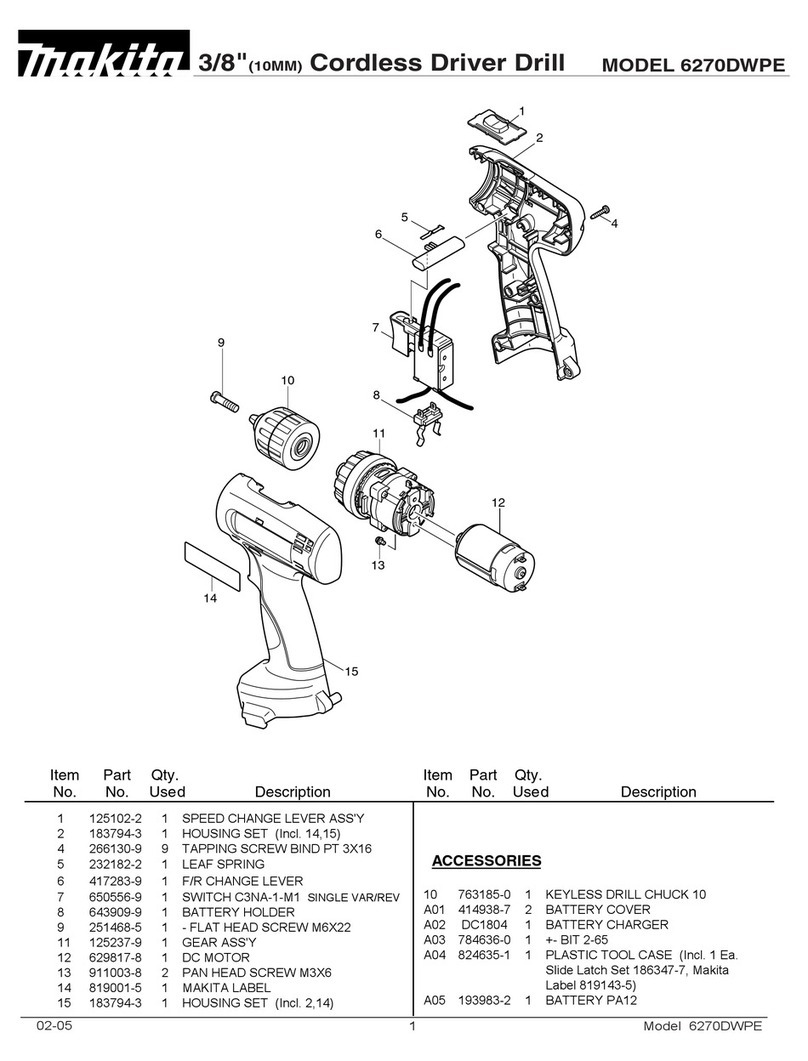
Makita
Makita 6270DWPE Parts Breakdown

Black & Decker
Black & Decker BDCDD12USB quick start guide
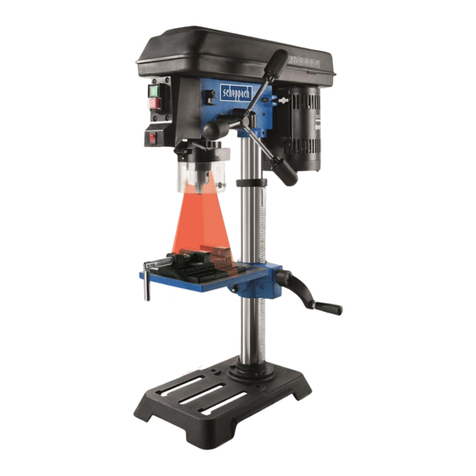
Scheppach
Scheppach DP16SL Translation of original instruction manual

Challenge
Challenge MS-10B Technical service and parts manual
